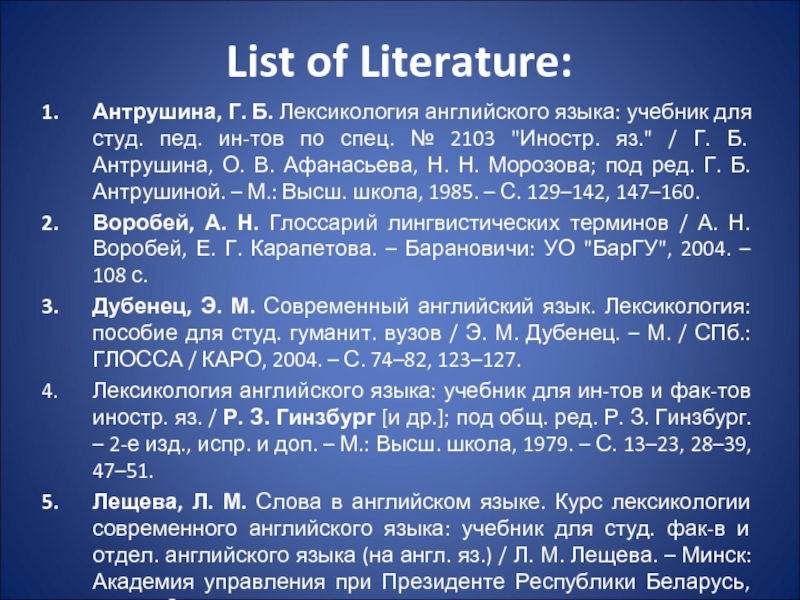5.1. Polysemantic
and monosemantic words. Classification
5.2. Diachronic
approach to polysemy.
5.3. Synchronic
approach to polysemy.
5.4. The
semantic structure of correlated words in English and Russian.
5.5. The
national character of the semantic structure.
5.1.
Polysemy
is the ability of words to have more than one meaning. A word with
several meanings is called polysemantic.
Monosemantic
words, which have only one meaning, are comparatively few; they are
mainly scientific terms (e.g. hydrogen) or rare words (e.g.
flamingo).
The bulk of English words are
polysemantic. All the meanings of a polysemantic word make up a
system which is called the semantic structure of the word.
e.g. The
word TABLE
has the semantic structure made up of at least 9 meanings:
-
piece of furniture;
-
the persons seated at a
table; -
(sing.) food put on the
table; -
a thin flat piece of
stone, metal, wood, etc.; -
(pl.) slabs of stone;
-
words cut into them or
written on them (the Ten Tables); -
an orderly arrangement of
facts, figures, etc.; -
part of a machine tool on
which work is put; -
a level area, a plateau.
5.2. Polysemy
can be viewed diachronically
and synchronically.
The system of meanings of a
polysemantic word develops gradually, mostly over centuries, as new
meanings are added to old ones or oust some of them. As a result, the
total number of meanings grows, and the vocabulary is enriched.
Thus,
polysemy
viewed diachronically
is a historic change in the semantic structure of a word that results
in disappearance of some meanings and appearance of new meanings, and
also in the rearrangement of the meanings in the semantic structure.
Diachronically,
we distinguish between the
primary meaning
and secondary
meanings
of a word.
The
primary meaning
is the oldest meaning of the word, its original meaning with which
the word first appeared in the language,
e.g. the
primary meaning of TABLE
is «slabs of stone»: O.E. tabule f. Lat tabula.
All the other meanings
appeared later than the primary meaning.
When we
describe a meaning as secondary
we imply that it can’t have appeared before the primary meaning; when
we say a meaning is derived we imply not only that but also that it
is dependent on another meaning and subordinate to it,
e.g. TABLE
1,2,3 are secondary, appeared later than TABLE 5;
TABLE 2, 3 are derived from
TABLE 1.
The main
source of polysemy is semantic
derivation
(radiation of meanings; adding new meanings to the existing ones).
Polysemy
may also result from homonymy.
When two words coincide in sound-form, their meanings come to be felt
as making up one semantic structure.
e.g. the
human EAR
(f. Lat auris) and the EAR
of corn
(f. Lat acus, aceris) diachronically are homonyms. Synchronically,
however, they are perceived as two meanings of one polysemantic word
ear. The ear of corn is felt to be a metaphoric meaning (Of.: the eye
of a needle, the foot of the mountain) and thus, as a derived meaning
of the word. Cases of this type are comparatively rare.
5.3.
Viewed
synchronically,
polysemy is understood as co-existence of several meanings of the
same word and their arrangement in the semantic structure.
The status
of individual meanings is not the same. We distinguish between the
central (=basic, major) meaning
and minor
meanings.
How do we determine which
meaning is the basic one?
(1) The basic meaning occurs
in various and widely different contexts. It is representative of the
word taken in isolation, i.e. it occurs to us when we hear/see the
word in isolation; that is why it is called a free meaning.
e.g. the
central meaning of TABLE is «a piece of furniture» Minor
meanings occur only in specific contexts,
e.g. to
keep the table amused (TABLE 2) or the table of contents (TABLE 7).
(2) The basic meaning has the
highest frequency in speech,
e.g. TABLE
1 has the highest frequency value and makes up 52% of all the uses of
the word; TABLE 7 accounts for 35%; all the other meanings between
them make up just 13% of all the uses.
(3) The basic meaning is
usually stylistically neutral and minor meanings are as a rule
stylistically coloured,
e.g.
YELLOW
1) coloured like egg yoke or gold (neutral),
2) sensational (Am slang),
3) cowardly (coll).
Synchronically,
we also distinguish between direct
meanings
and figurative
(transferred) meanings,
e.g. YELLOW 4) (fig) (of
looks, mood, feelings, etc.) jealous, envious, suspicious.
We should note that a word may
have two or more central meanings,
e.g. GET
«obtain» and «arrive» are equally central in the
semantic structure.
As the semantic structure of a
word is never static, the status (type) of its meanings may change in
the course of time. The primary meaning may become a minor one; a
secondary meaning may become the central meaning of a word.
e.g. The
primary meaning of QUICK
is «living»; it is still retained in the semantic structure
but has become a minor meaning which occurs only in some expressions:
to touch/ wound to the quick, the quick and the dead; «rapid,
fast» has become the central meaning.
5.4.
Words of different languages are said to be correlated when their
central meanings coincide,
e.g. table
– cтол
«piece of furniture».
But there
is practically no one-to-one correspondence between the semantic
structures of correlated polysemantic words of different languages.
The relations between correlated words are quite complicated, and we
may single out the following cases (and show them graphically).
The semantic structures of two
correlated words may coincide; usually they are monosemantic words,
e.g.
flamingo.
W
can show this relationship like this: two overlapping circles.
If the
number of meanings is different, the semantic structure of one word
may include that of its correlate it is the relationship of
inclusion,
e.g.
MEETING
1) a gathering of people for a purpose
2
the people in such a gathering
3) the coming together of
two or more people, by chance or arrangement
МИТИНГ
a (political) gathering of a number of people».
Some meanings of two
correlated words may coincide and the others don’t. This is the
relationship of intersection.
e
BOY МАЛЬЧИК
1) male child 1) male
child,
-
young man 2) apprentice
(obs.), -
male native servant,
-
junior sailor.
5.5.
All lexical meanings of a polysemantic word are interconnected.
The relations beween them are based on various logical and
psychological associations. Some of these relations are common to all
or to many languages; others are peculiar to a particular language.
Thus, a semantic structure has a national character (some specific
characteristics).
Relations
that
are common to all/most languages are:
1)
metaphorical
relations,
e.g ass
1
«animal»
— осёл
1
«animal»,
ass 2
(fig)
«stupid person» — осёл2
«person».
2)
metonymic
relations,
e.g. table
1
«piece of furniture» — стол
1
«piece of furniture»,
table 3
«food«
– стол
3
«food
put on (1)
«.
Relations
typical of English, but not of Russian are:
1.
One and the same English verb may have both transitive and
intransitive meanings in its semantic structure,
e.g. Paper
burns easily. (intr)
Cf.:
гореть,
She burnt his letters, (tr)
жечь.
2. One
word has countable and uncountable, concrete and abstract meanings,
e.g. his
love of painting Сf.:живопись
— the
paintings on the wall картина,
coal — a coal, hair — a
hair.
3. In the same semantic
structure we find individual and collective meanings,
e.g.
YOUTH 1) young people collectively Сf.: молодежь,
-
a young man – юноша,
-
the
state of being young — юность.
Соседние файлы в предмете [НЕСОРТИРОВАННОЕ]
- #
- #
- #
- #
- #
- #
- #
- #
- #
- #
- #
-
-
March 31 2015, 21:55
Monosemantic, formed by slapping the prefix mono- (one) onto semantic (related to meaning), means having only one meaning. It is usually applied to words and phrases that fit this definition. I suppose that doesn’t sound too impressive, but it is! Words can go through so many transformations and expansions over time that you can make yourself dizzy tracing all of the twists and turns from their earliest recorded sense to their modern one. Hurray for monosemantic words, the stalwarts of language! Though you have to wonder why they failed to evolve. Maybe they were left alone because they were too dull to bother with. Then again, maybe whoever coined them managed to get it right the first time, and why mess with perfection?
Every word in any language has значение /meaning/ ( we also say лексическое значение /lexical meaning/), which is an object, characteristic or action named by a word. For example, meaning of the word «язык» /tongue/ — «орган, при помощи которого мы говорим» /part of the body, with the help of which we speak/.
According to the number of meanings, words are divided into monosemantic and polysemous. Monosemantic words have one meaning, polysemous have two or more. A lot of terms, for instance, кислород /oxygen/ (О2) or делитель /divider/ (in the question 4:2 2 is a divider) are monosemantic words. Not only terms can be monosemantic. Trousers is also a monosemantic word. However, many words in language have several meanings. Why? This way language, saving its means, widers its possibilities.
Язык is a polysemous word. Let’s take a look at what it means in Russian.
1. Язык is part of the body, with the help of which we speak. Чтобы произнести звук [л`], надо кончиком языка коснуться верхних зубов /To pronounce the sound [л`] we need to touch upper teeth with a tip of our tongue/.2. Язык is something a person tells. Придержи язык /curb the tongue/ means be quiet, think before speaking.3. Язык is a system of sounds, words and rules of their forming and usage. Русский язык /Russian language/. Английский язык /English language/.4. Язык is a sign system. Язык программирования /Language of programming/. Java — это язык программирования /Java is the language of programming/.5. Язык is a way of expressing thoughts or feelings. Язык цифр /Language of numbers/. Язык любви /Language of love/.6. Язык is a style of conversation. Язык науки /Language of sciense/. Язык газет /Language of newspapers/.7. Язык is a captive, who can tell information about opposing side. Военные обычно говорят: «мы взяли языка» /The military usually say, »We’ve taken a hostage»/.8. Язык is a metalic core in a bell, with the help of which it tolls. 9. Язык is somehing having oblong form. Язык пламени (пламя = огонь) /Tongues of flame (flame = fire)/.
As you can see, the word «язык» in Russian has as many as nine meanings! The first of them we call direct, for it denotes an object. The others are figurative. They have appeared later. Why do metalic core in a bell is also called «язык»? Because it resemles human’s tongue and has similar function: with the help of tongue a bell «speaks», produces sounds.
Слайд 1Lecture 3
Semantic Structure of the Word
and Its Changes
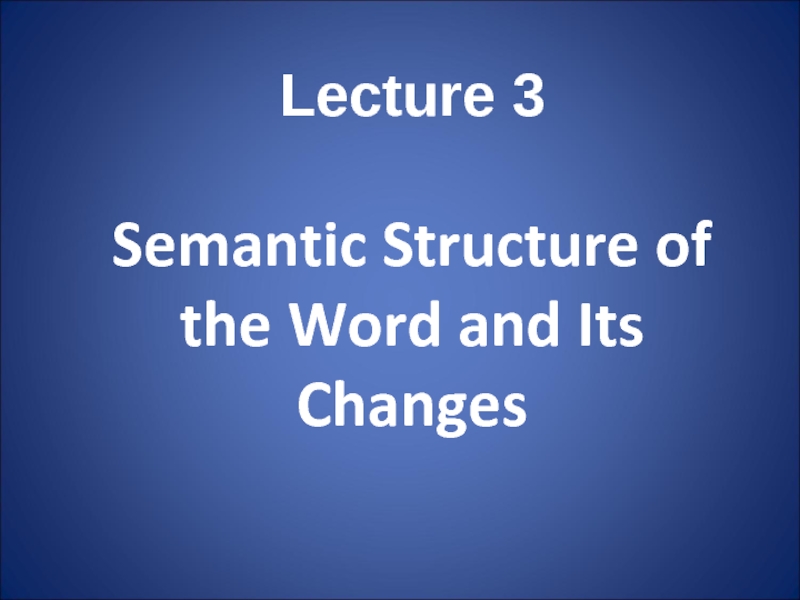
Слайд 2Plan:
Semantics / semasiology. Different approaches to word-meaning.
Types
of word-meaning.
Polysemy. Semantic structure of words.
Meaning and context.
Change of word-meaning: the causes, nature and results.
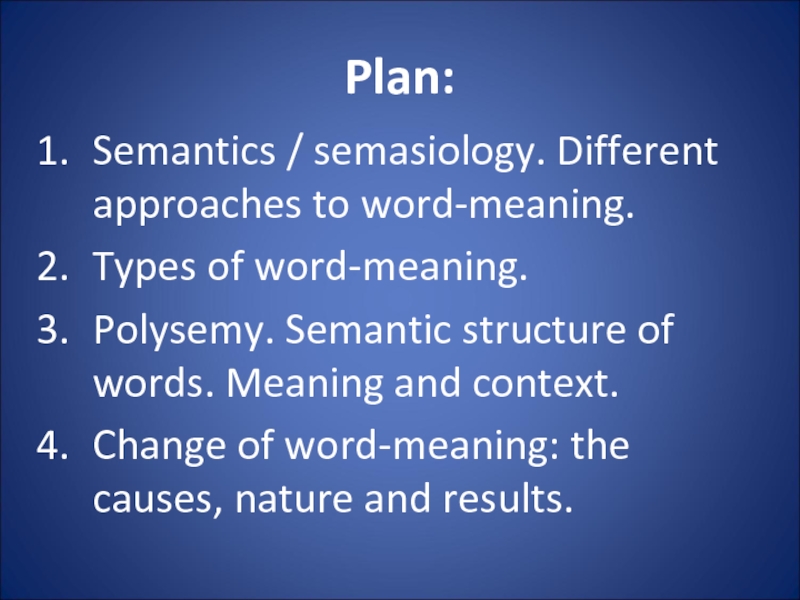
Слайд 3List of Terms:
semantics
referent
referential meaning
grammatical meaning
lexical meaning
denotational meaning
connotational
meaning
polysemantic word
polysemy
lexical-semantic variants
basic meaning
peripheral meaning
primary meaning
secondary meaning
radiation
concatenation
lexical
context
grammatical context
thematic context
ellipsis
differentiation of synonyms
linguistic analogy
metaphor
metonymy
restriction of meaning
extension of meaning
ameliorative development of meaning
pejorative development of meaning
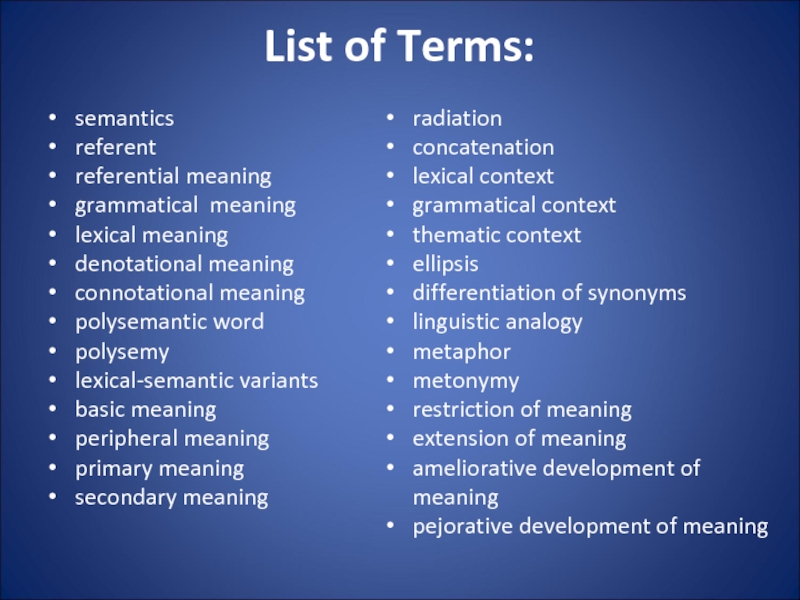
Слайд 4
It is meaning that makes language
useful.
George A. Miller,
The science of
word, 1991
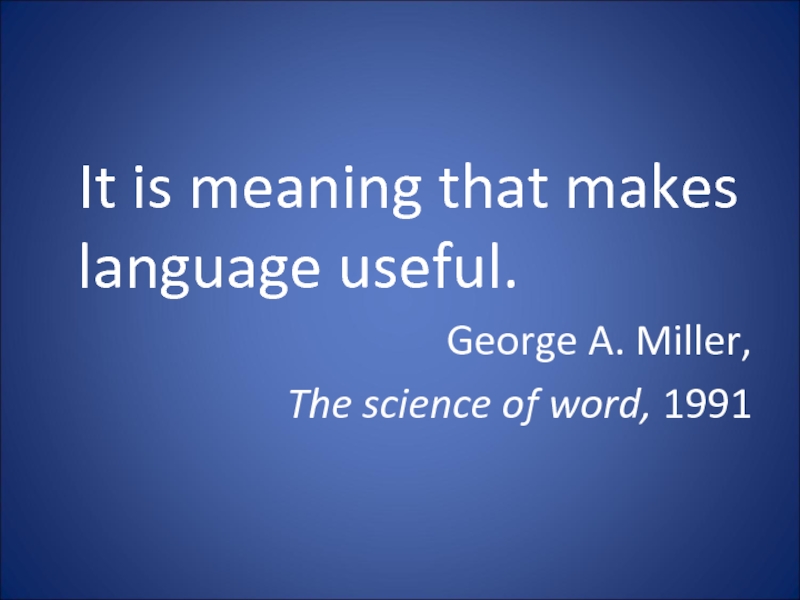
Слайд 5
1. Semantics / semasiology. Different approaches to
word-meaning
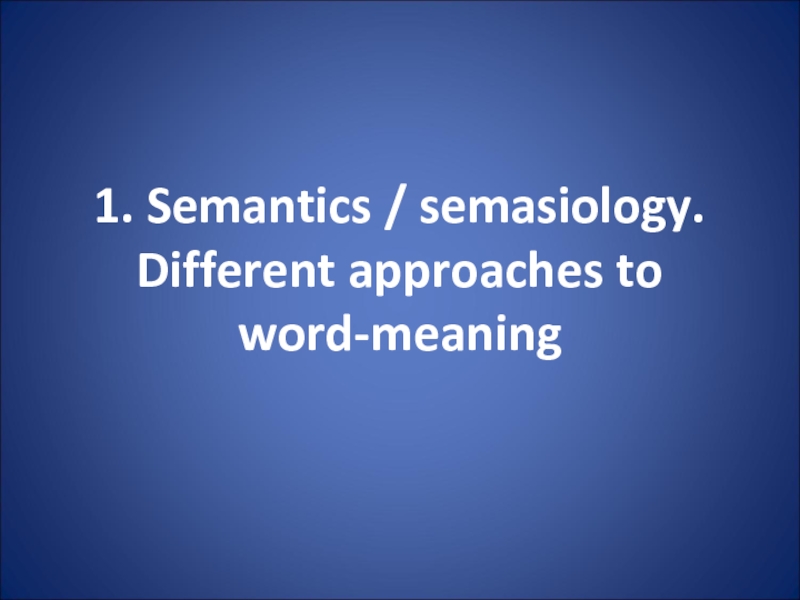
Слайд 6
The function of the word
as a unit of communication is possible
by its possessing a meaning.
Among the word’s various characteristics meaning is the most important.
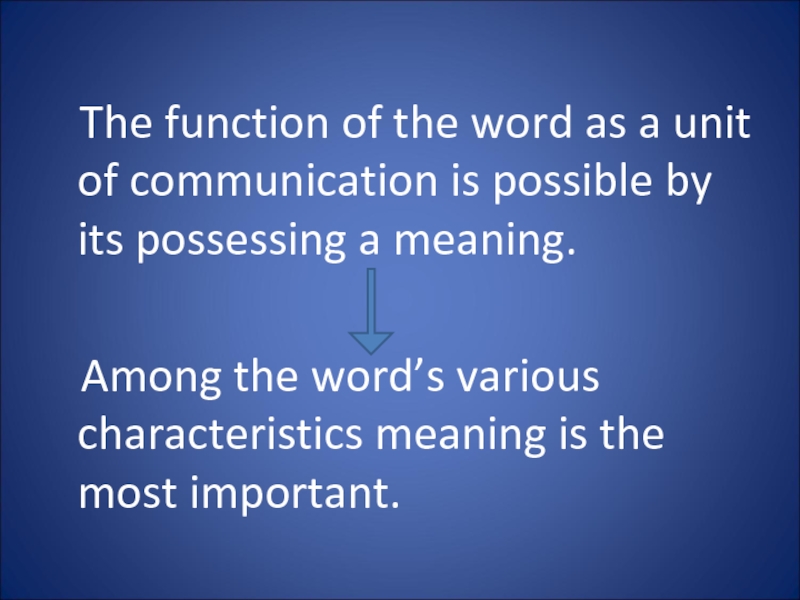
Слайд 7
«The Meaning of Meaning» (1923) by C.K.
Ogden and I.A. Richards – about 20
definitions of meaning
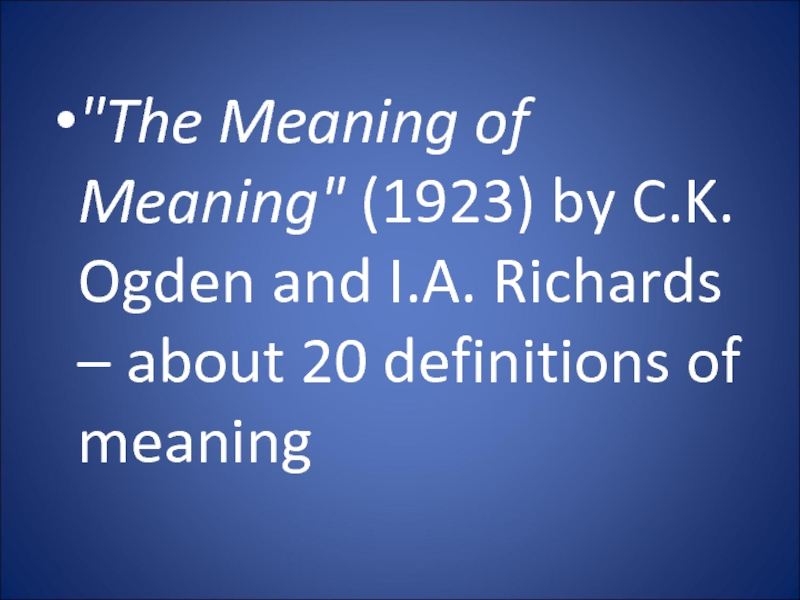
Слайд 8Meaning of a linguistic unit, or linguistic
meaning, is studied by semantics
(from Greek
– semanticos ‘significant’)
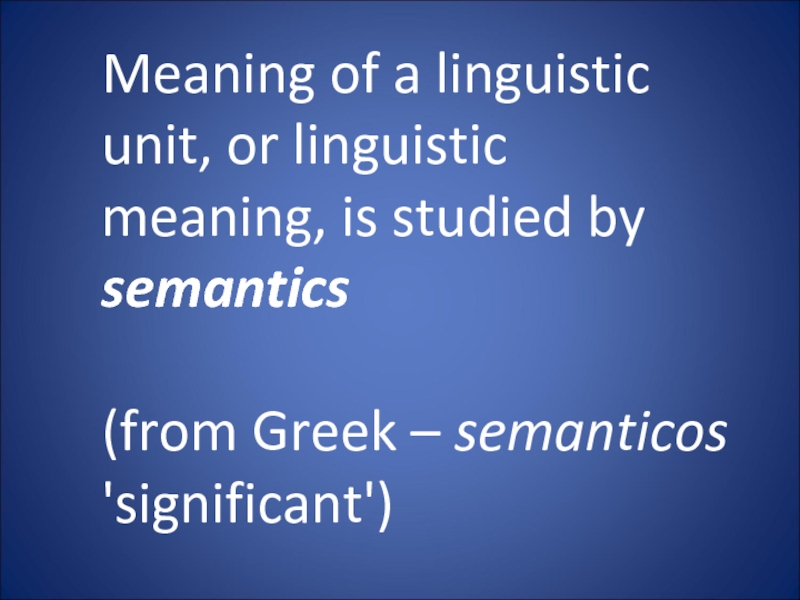
Слайд 9
This linguistic study was pointed
out in 1897 by M. Breal

Слайд 10
Semasiology is a synonym for
‘semantics’
(from Gk. semasia ‘meaning’
+ logos ‘learning’)
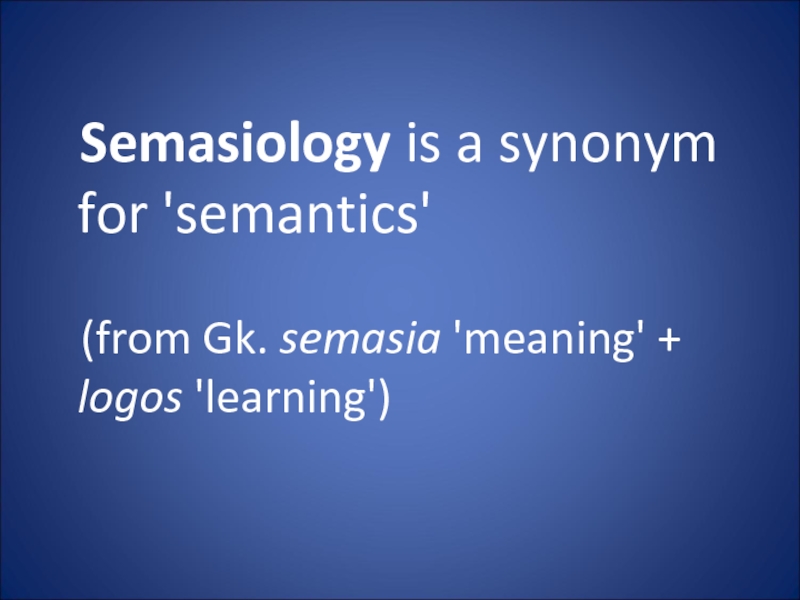
Слайд 11Different Approaches to Word Meaning:
ideational (or conceptual)
referential
functional
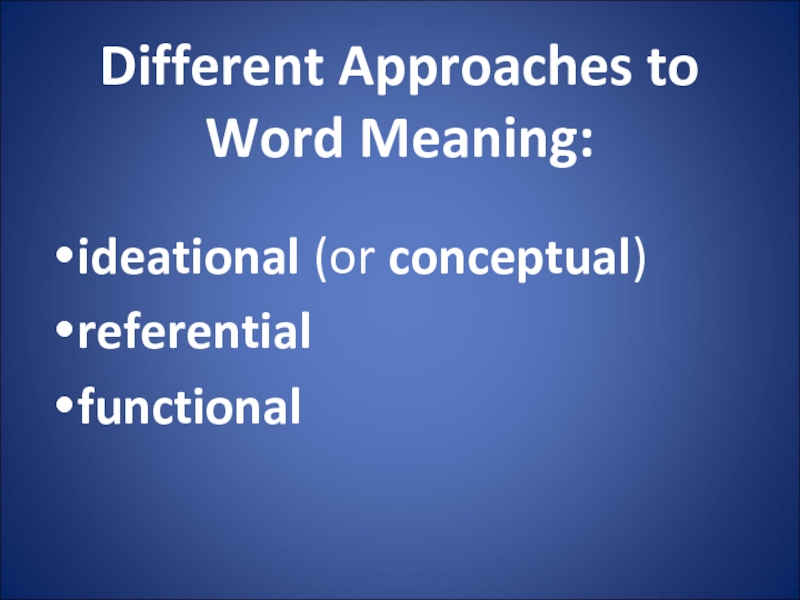
Слайд 12
The ideational theory can be
considered the earliest theory of meaning.
It states that meaning originates in the mind in the form of ideas, and words are just symbols of them.

Слайд 13A difficulty:
not clear why communication and
understanding are possible if linguistic expressions stand
for individual personal ideas.

Слайд 14Meaning:
a concept with specific structure.
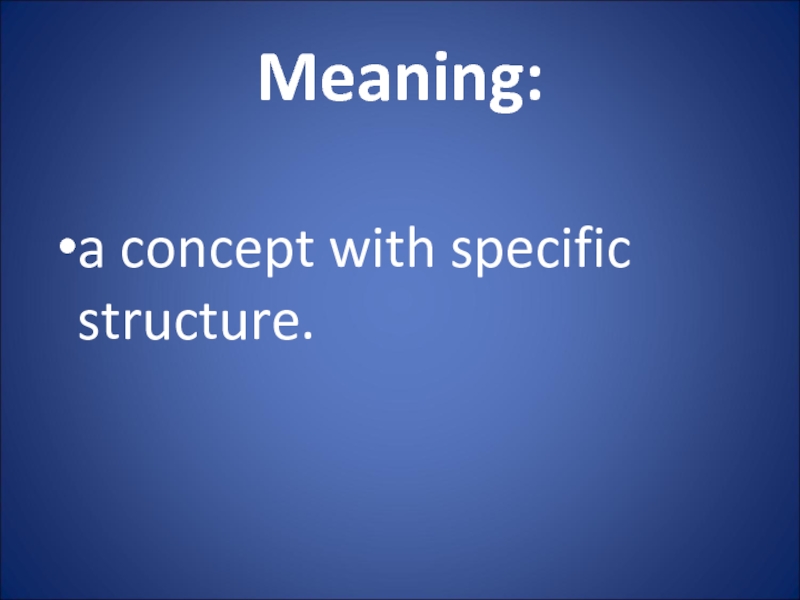
Слайд 15
Do people speaking different languages have different
conceptual systems?
If people speaking different languages
have the same conceptual systems why are identical concepts expressed by correlative words having different lexical meanings?
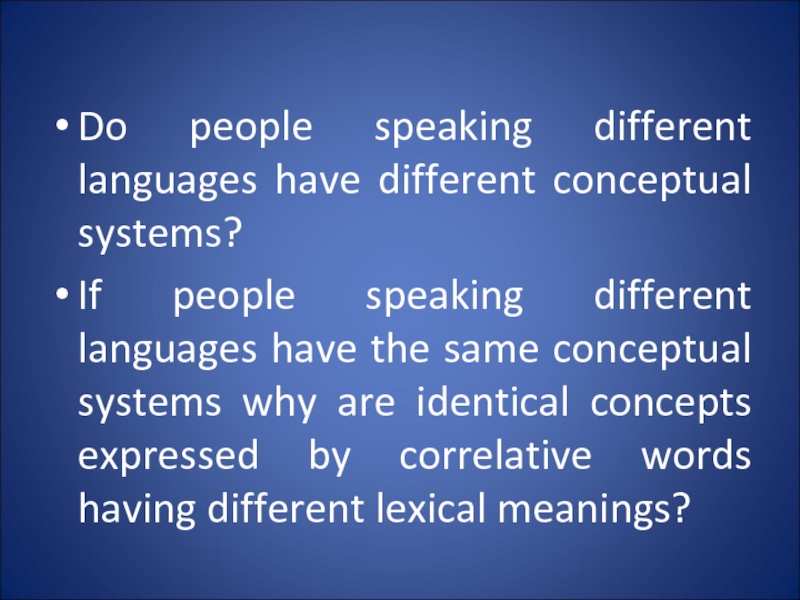
Слайд 16
finger ‘one of 10 movable parts of
joints at the end of each human
hand, or one of 8 such parts as opposed to the thumbs‘
and
палец ‘подвижная конечная часть кисти руки, стопы ноги или лапы животного’
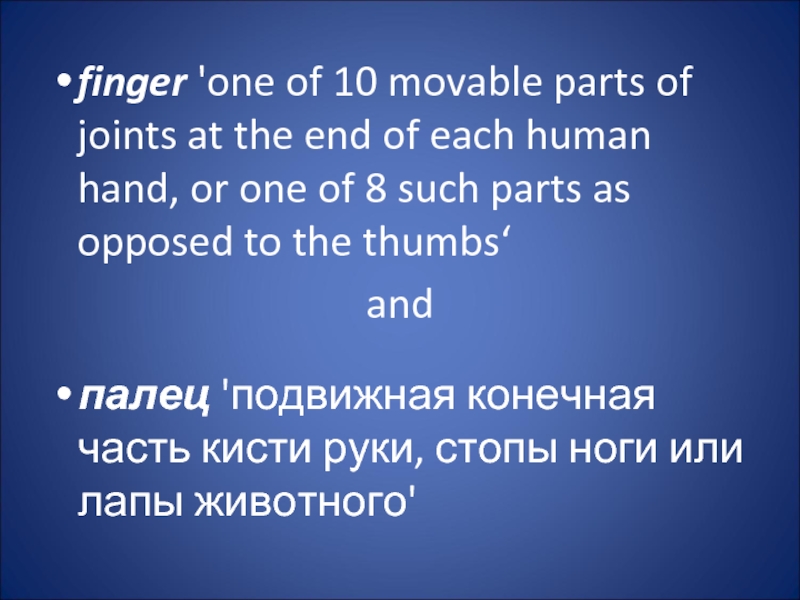
Слайд 17
Referential theory is based
on interdependence of things, their concepts and
names.
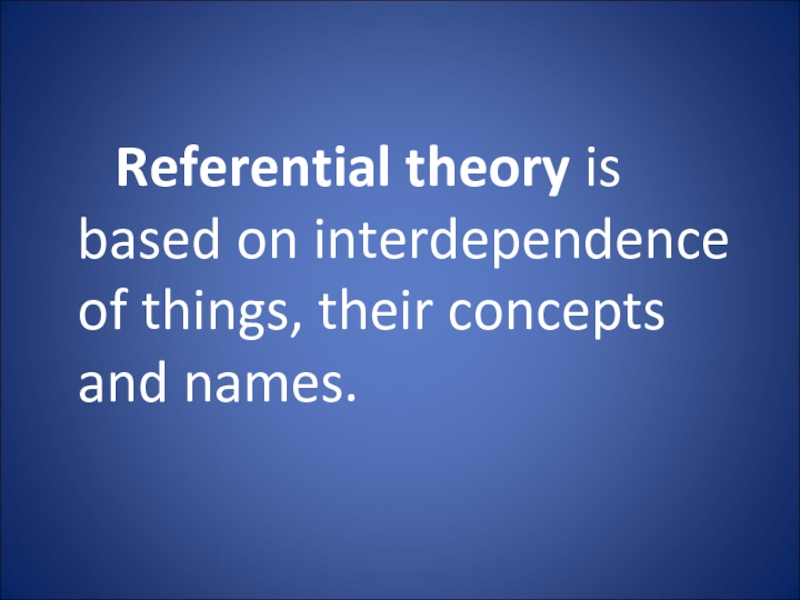
Слайд 18
The complex relationships between referent
(object denoted by the word), concept and
word are traditionally represented by the following triangle:
Thought = concept
Symbol = word Referent = object
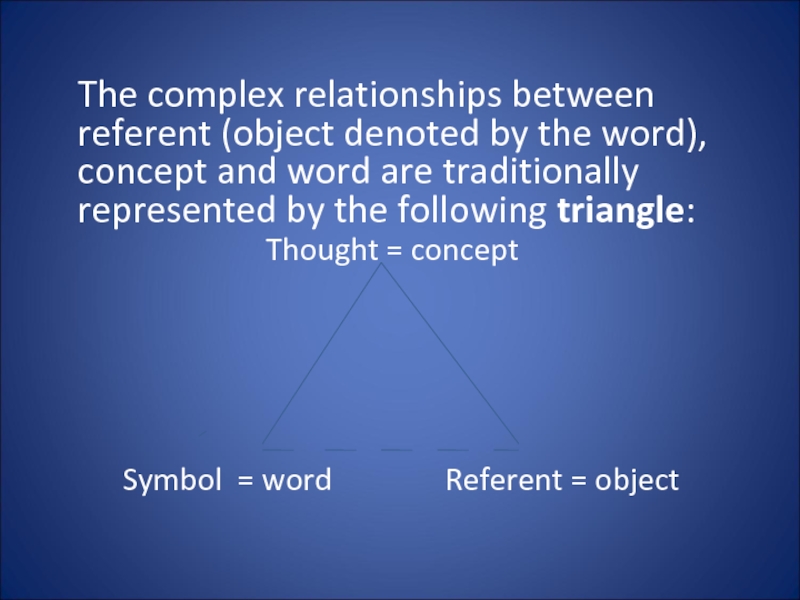
Слайд 19
an animal, with 4
legs and a
tail, can bark and bite
dog
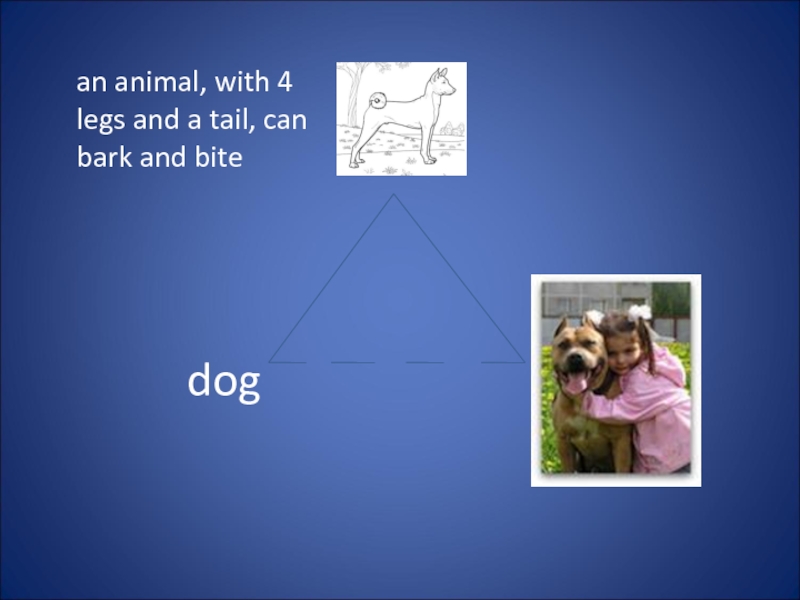
Слайд 20Meaning concept
different words having
different meanings may be used to express
the same concept
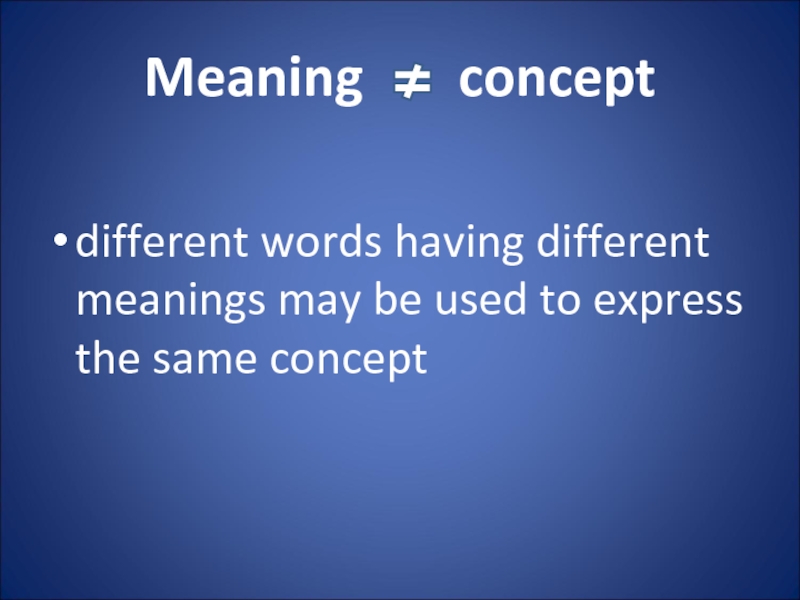
Слайд 21Concept of dying
die
pass away
kick the
bucket
join the majority, etc

Слайд 22Meaning symbol
In different languages:
a
word with the same meaning have different
sound forms (dog, собака)
words with the same sound forms have different meaning (лук, look)
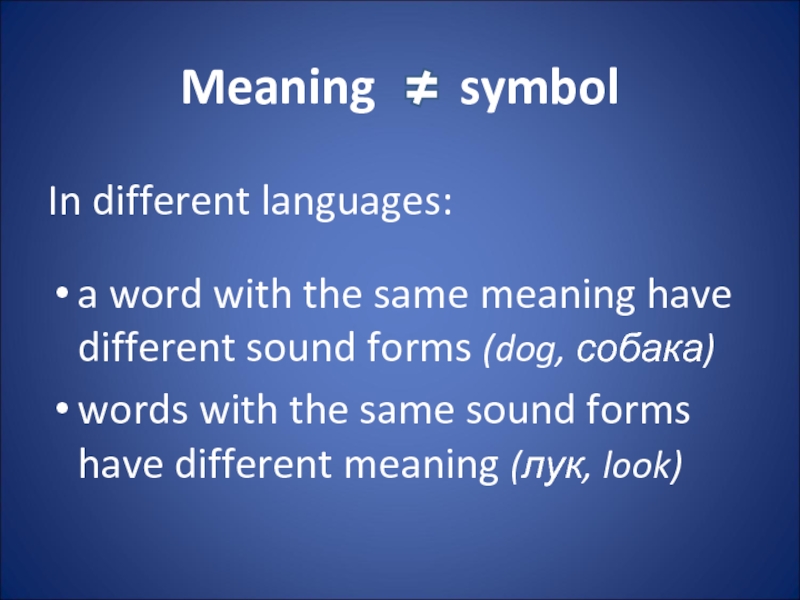
Слайд 23Meaning referent
to denote one
and the same object we can give
it different names
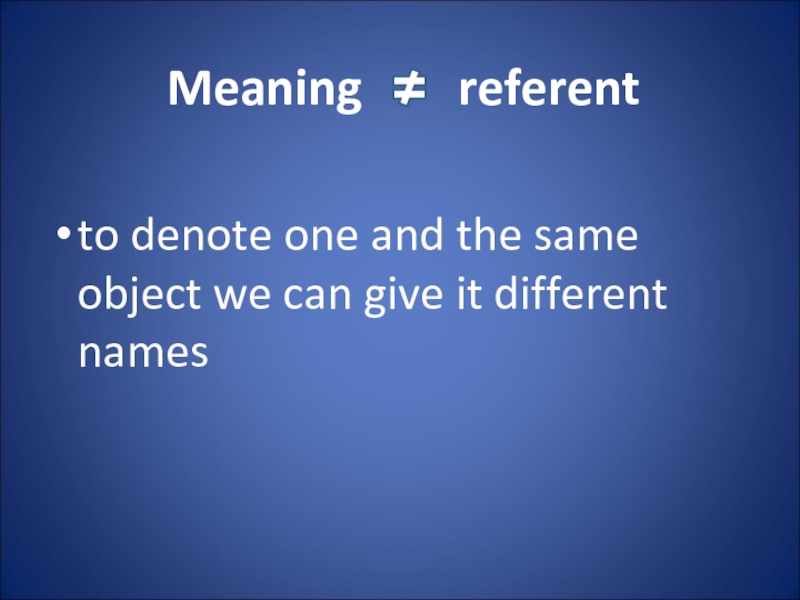
Слайд 24A horse
in various contexts:
horse,
animal,
creature,
it,
etc.
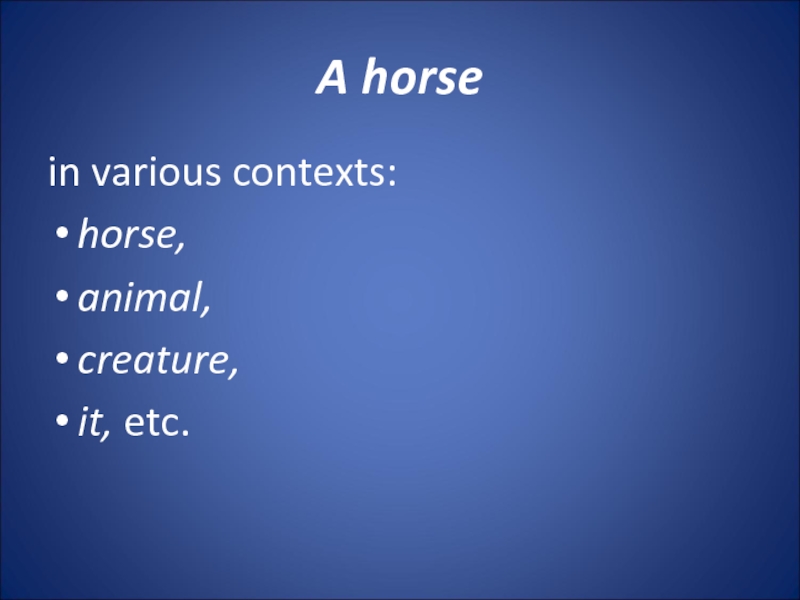
Слайд 25Word meaning:
the interrelation of
all three components of the semantic triangle:
symbol, concept and referent, though meaning is not equivalent to any of them.
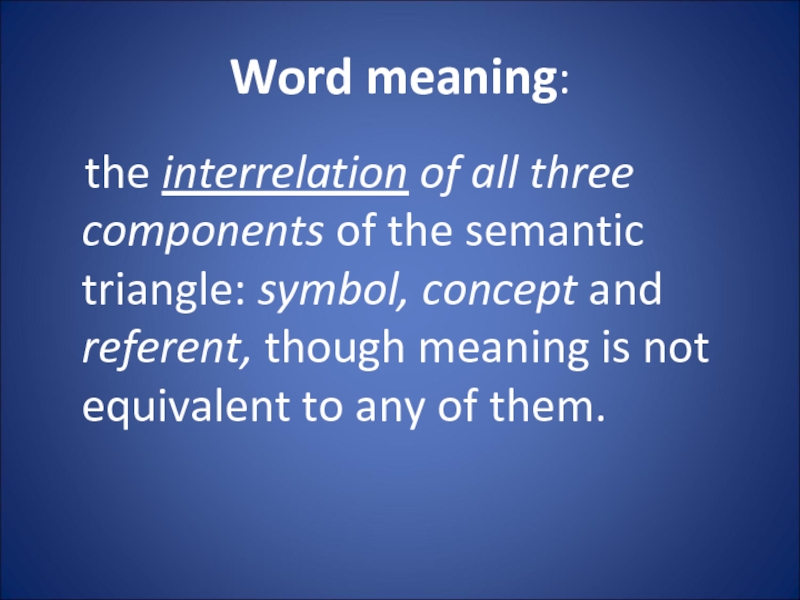
Слайд 26
Functionalists study word meaning by
analysis of the way the word is
used in certain contexts.
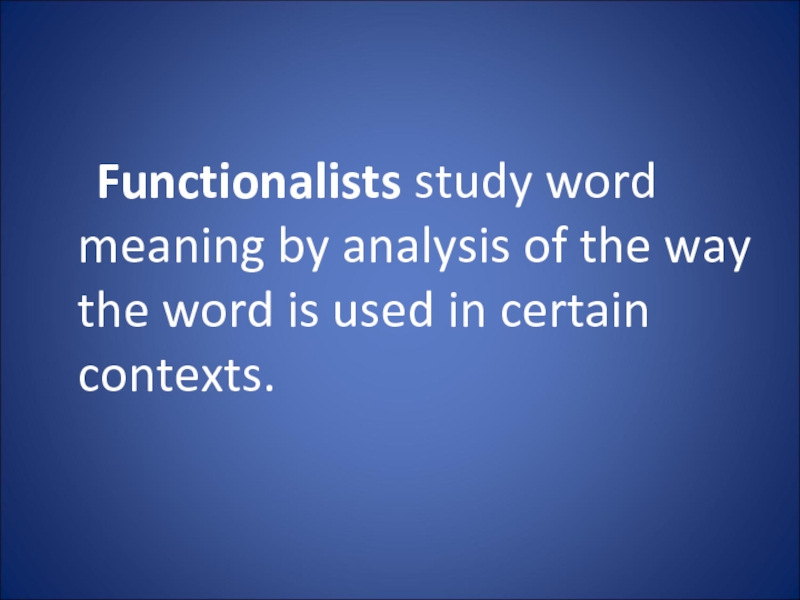
Слайд 27
The meaning of a
word is its use in language.
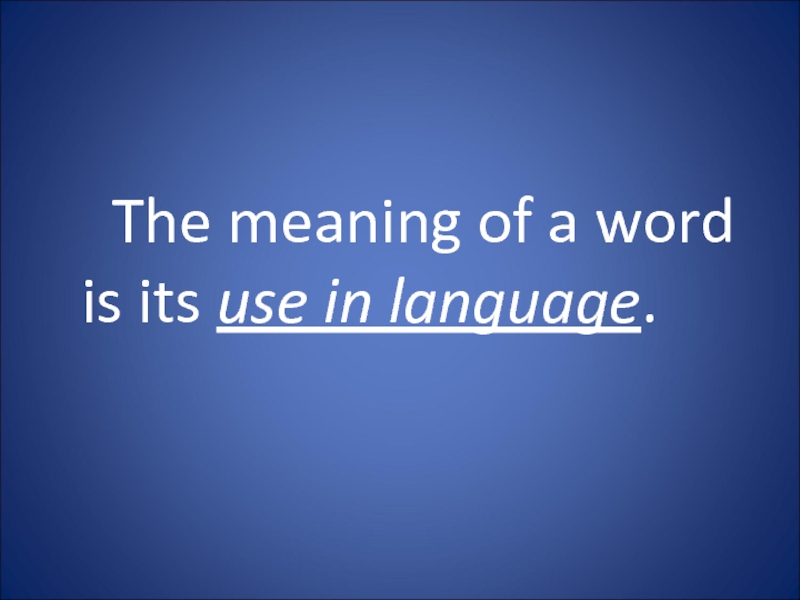
Слайд 28cloud and cloudy
have different meanings because
in speech they function differently and occupy
different positions in relation to other words.
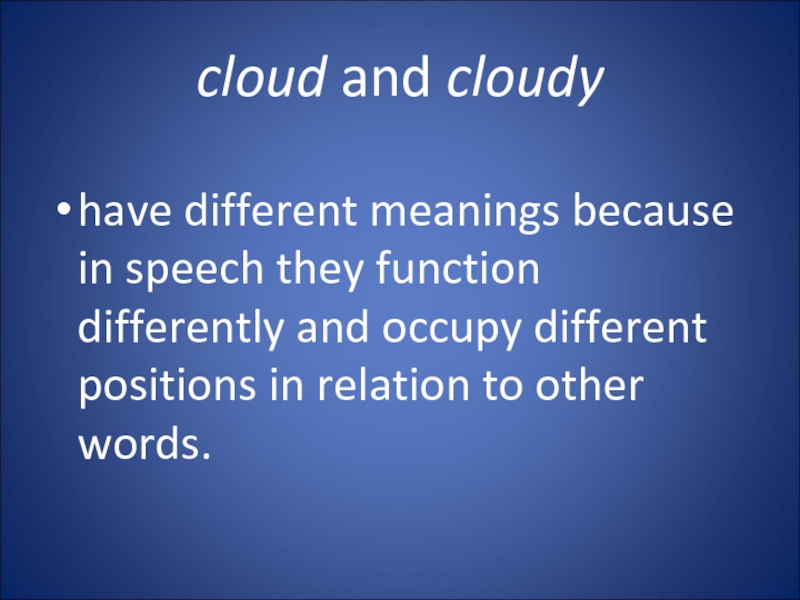
Слайд 29Meaning:
a component of the word
through which a concept is communicated
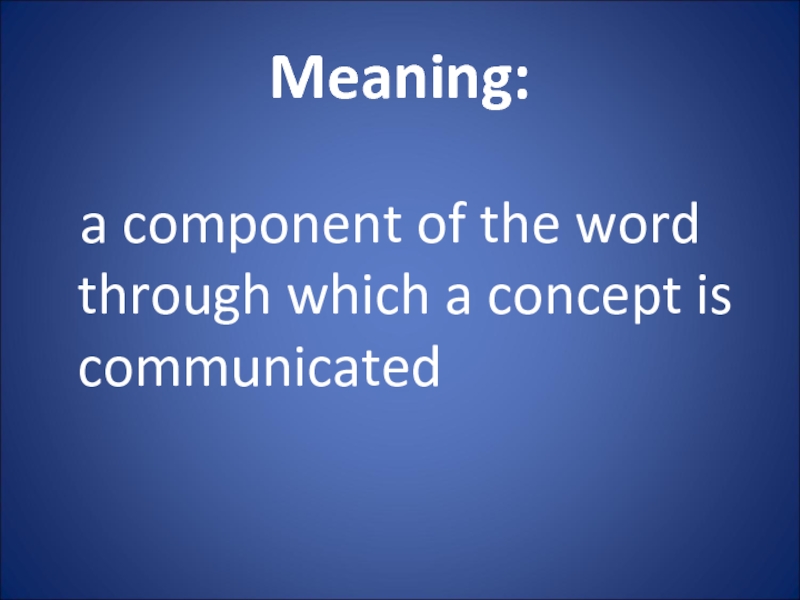
Слайд 31According to the conception of word meaning
as a specific structure:
functional meaning: part of
speech meaning (nouns usually denote «thingness», adjectives – qualities and states)
grammatical: found in identical sets of individual forms of different words (she goes/works/reads, etc.)
lexical: the component of meaning proper to the word as a linguistic unit highly individual and recurs in all the forms of a word (the meaning of the verb to work ‘to engage in physical or mental activity’ that is expressed in all its forms: works, work, worked, working, will work)
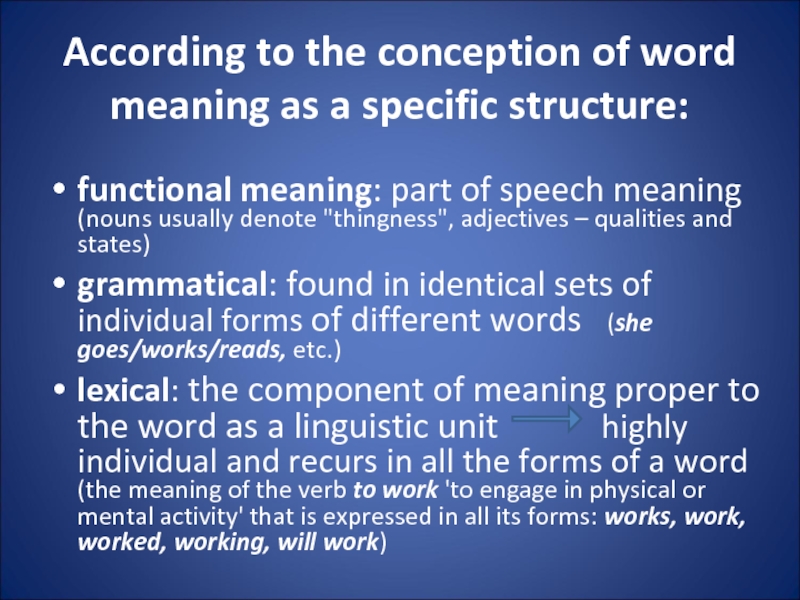
Слайд 32Lexical Meaning:
denotational
connotational
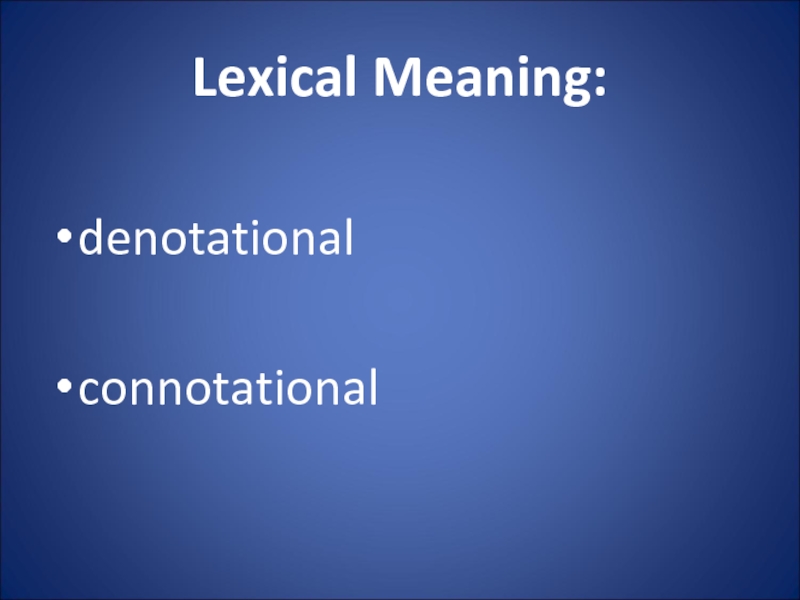
Слайд 33
Denotational lexical meaning provides correct reference of
a word to an individual object or
a concept.
It makes communication possible and is explicitly revealed in the dictionary definition (chair ‘a seat for one person typically having four legs and a back’).

Слайд 35
Connotational lexical meaning is an
emotional colouring of the word. Unlike denotational
meaning, connotations are optional.
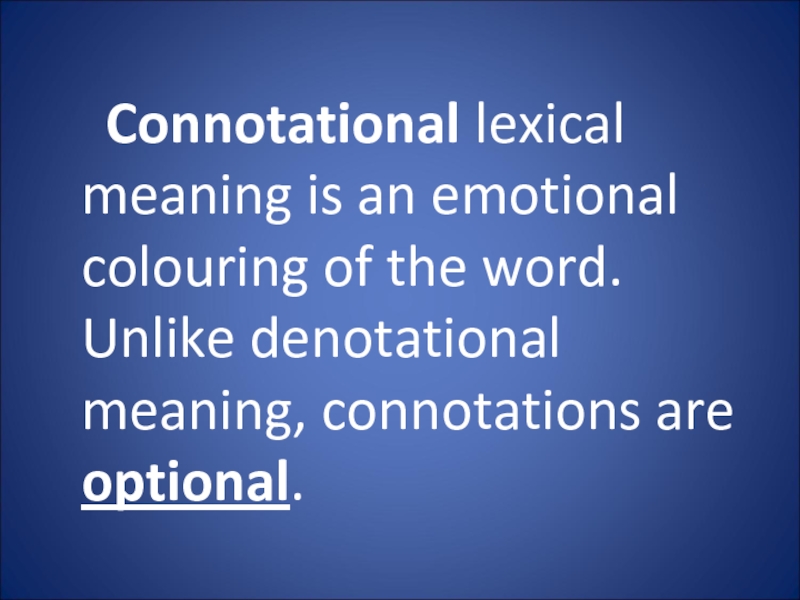
Слайд 36Connotations:
Emotive charge may be inherent in word
meaning (like in attractive, repulsive) or may
be created by prefixes and suffixes (like in piggy, useful, useless).
It’s always objective because it doesn’t depend on a person’s perception.
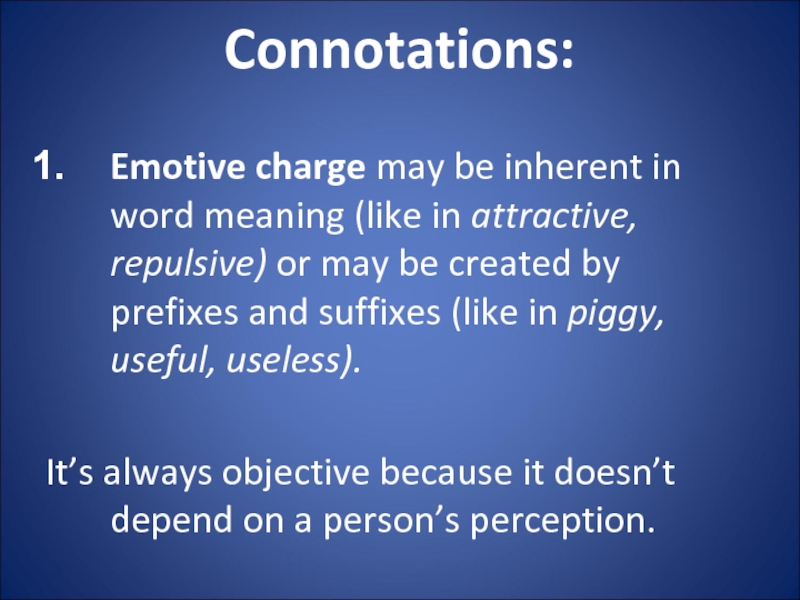
Слайд 37
2. Stylistic reference refers the word to
a certain style:
neutral words
colloquial
bookish, or literary words
Eg. father – dad – parent .
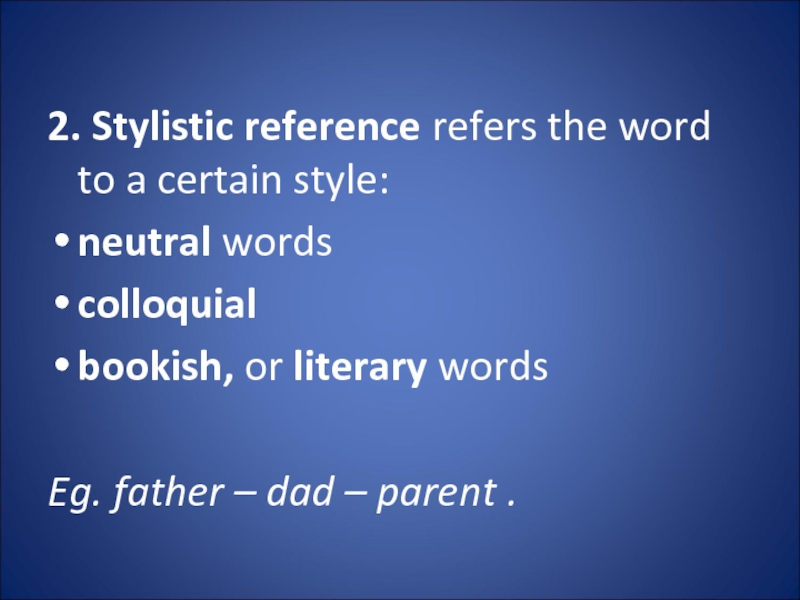
Слайд 38
3. Evaluative connotations express approval or disapproval
(charming, disgusting).
4. Intensifying connotations are expressive and
emphatic (magnificent, gorgeous)

Слайд 39
Denotative component
Lonely = alone, without company
To glare
= to look
Connotative component
+ melancholy, sad
(emotive con.)
+ 1) steadily, lastingly (con. of duration)
+ 2) in anger, rage (emotive con.)
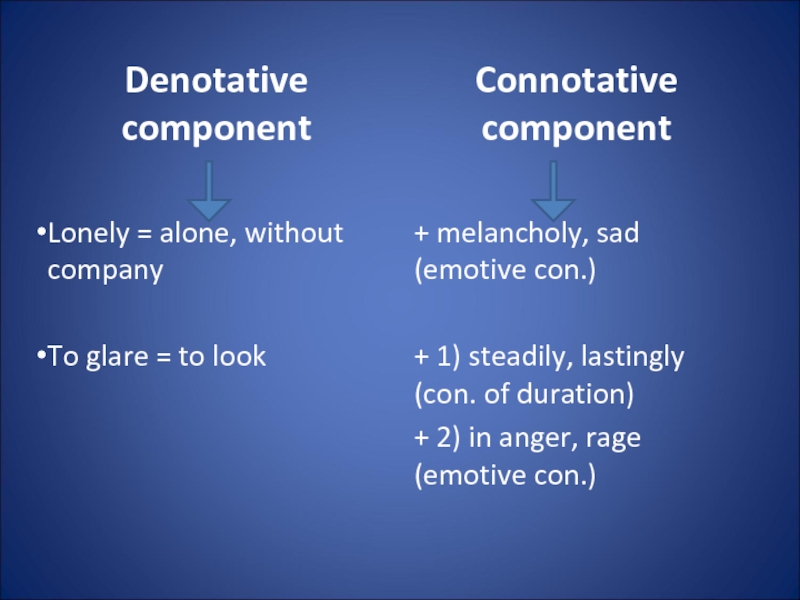
Слайд 40
3. Polysemy. Semantic structure of words. Meaning
and context
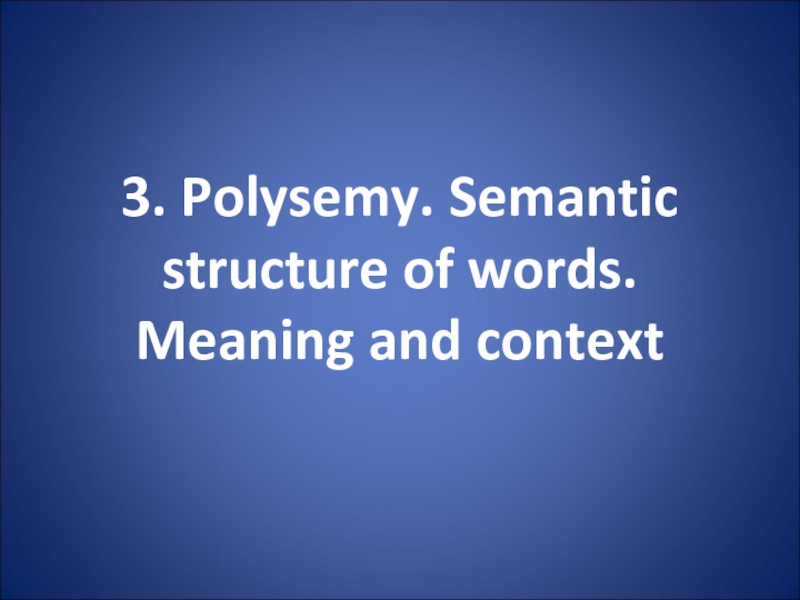
Слайд 41
A polysemantic word is a word having
more than one meaning.
Polysemy is the ability
of words to have more than one meaning.
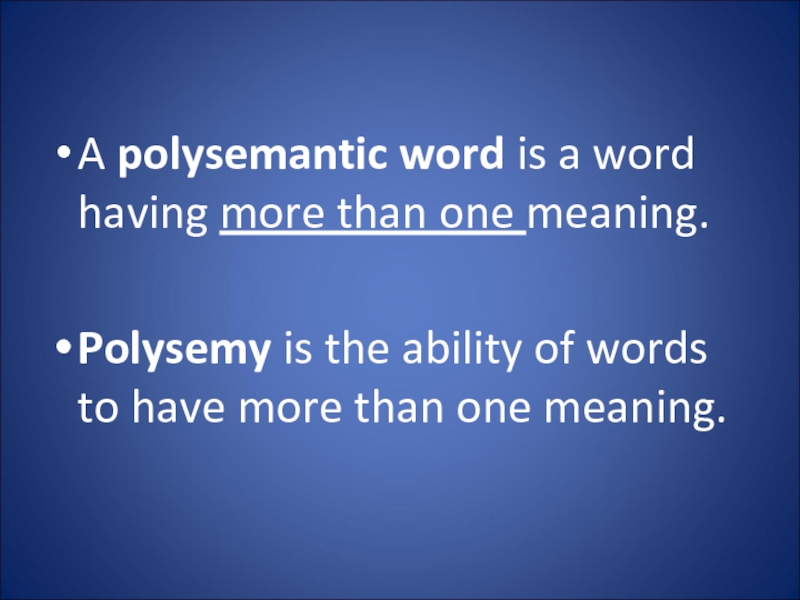
Слайд 42
Most English words
are polysemantic.
A well-developed polysemy
is a great advantage in a language.
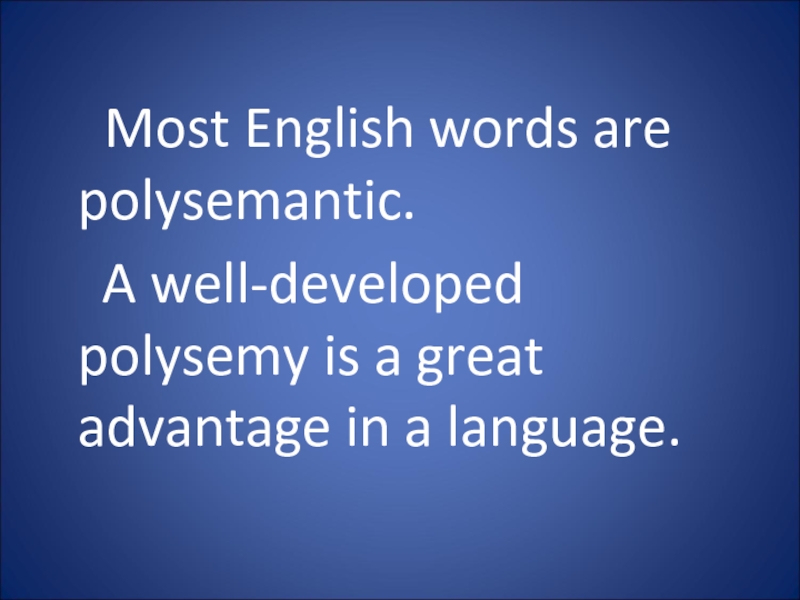
Слайд 43Monosemantic Words:
terms (synonym, bronchitis, molecule),
pronouns (this,
my, both),
numerals, etc.
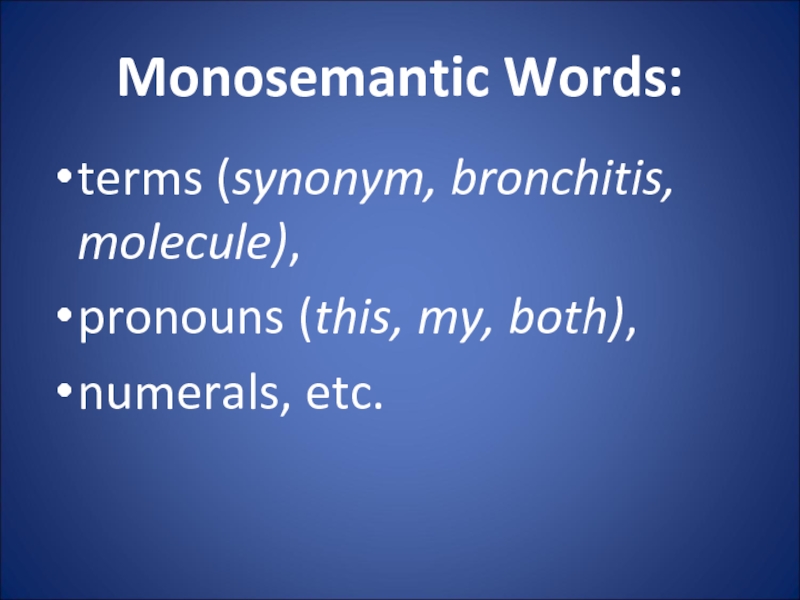
Слайд 44The main causes of polysemy:
a large number
of:
1) monosyllabic words;
2) words of
long duration (that existed for centuries).
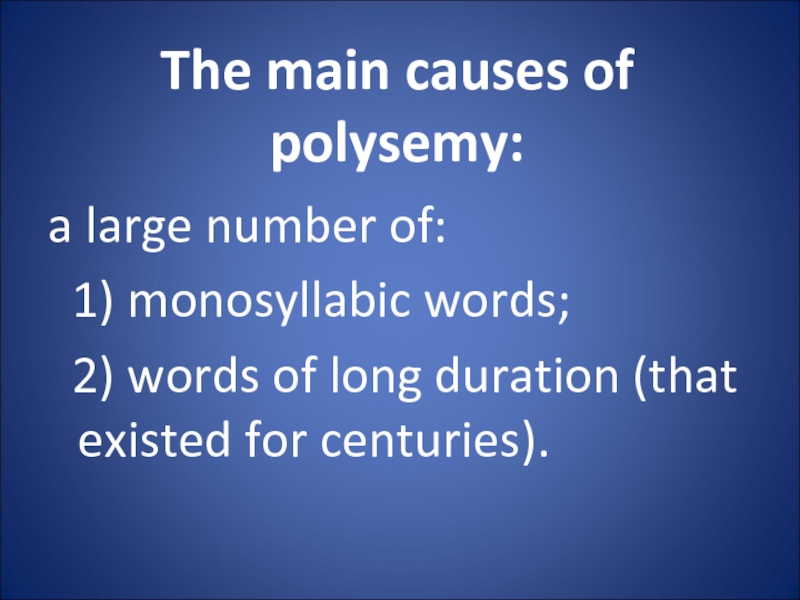
Слайд 45The sources of polysemy:
1) the process of
meaning change (meaning specialization: is used in
more concrete spheres);
2) figurative language (metaphor and metonymy);
3) homonymy;
4) borrowing of meanings from other languages.
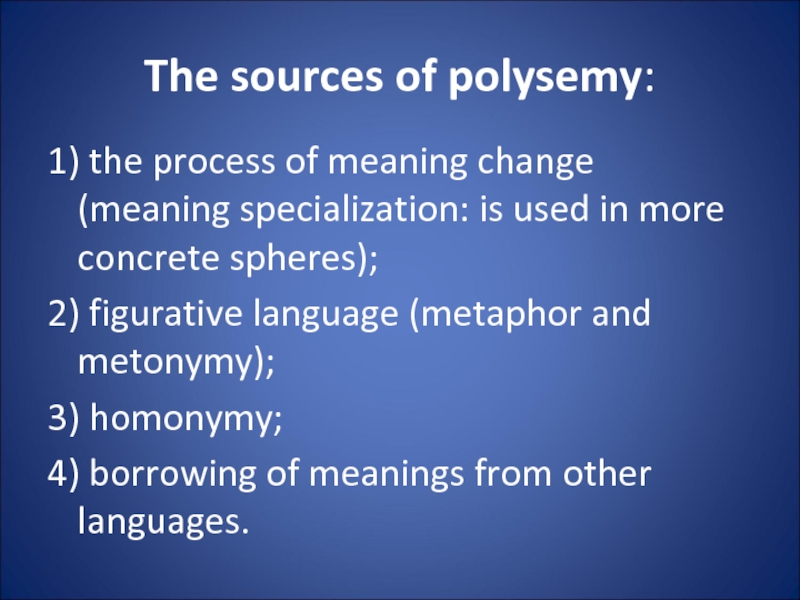
Слайд 46blanket
a woolen covering used on beds,
a covering
for keeping a house warm,
a covering
of any kind (a blanket of snow),
covering in most cases (used attributively), e.g. we can say: a blanket insurance policy.
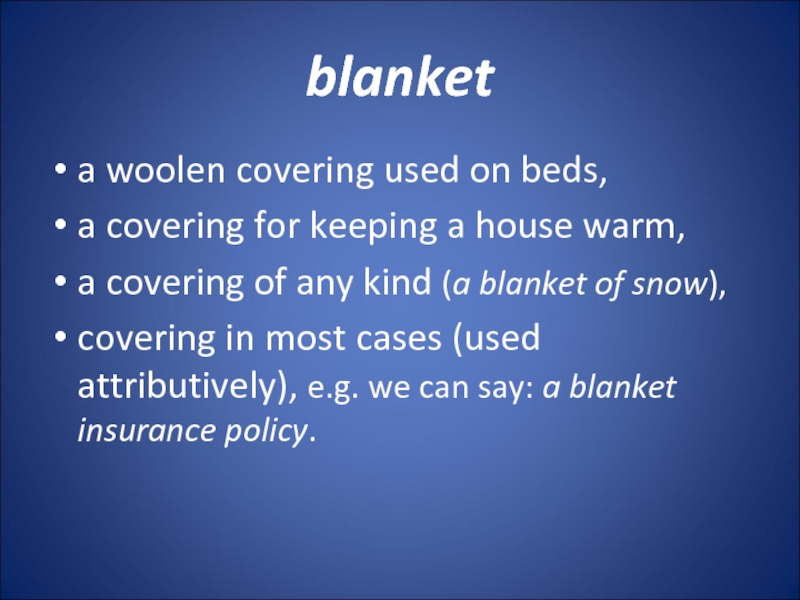
Слайд 47
Meanings of a polysemantic word
are organized in a semantic structure
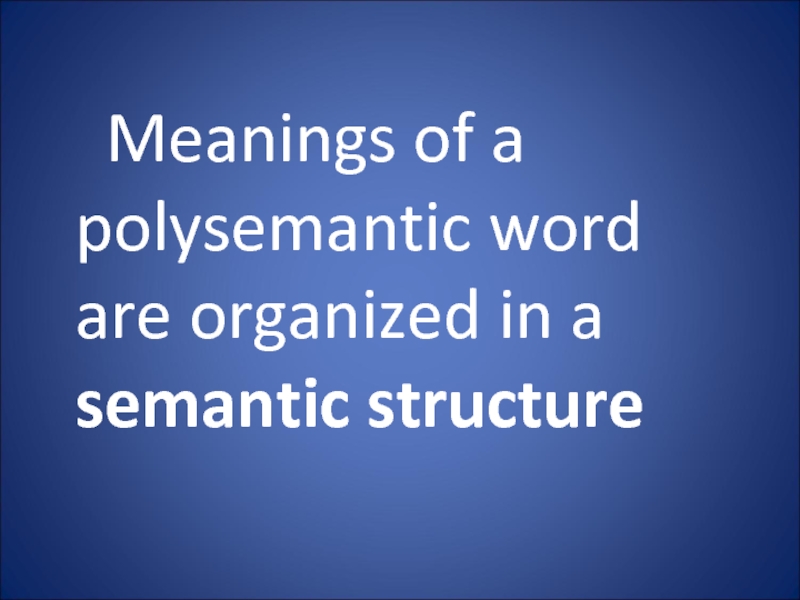
Слайд 48Lexical-semantic variant
one of the meanings of
a polysemantic word used in speech
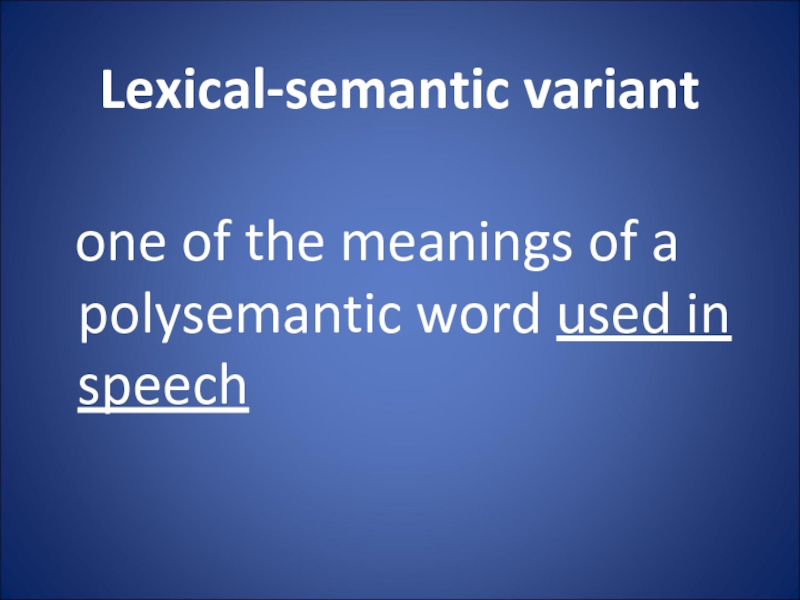
Слайд 49A Word’s Semantic Structure Is Studied:
Diachronically (in
the process of its historical development): the
historical development and change of meaning becomes central. Focus: the process of acquiring new meanings.
Synchronically (at a certain period of time): a co-existence of different meanings in the semantic structure of the word at a certain period of language development. Focus: value of each individual meaning and frequency of its occurrence.
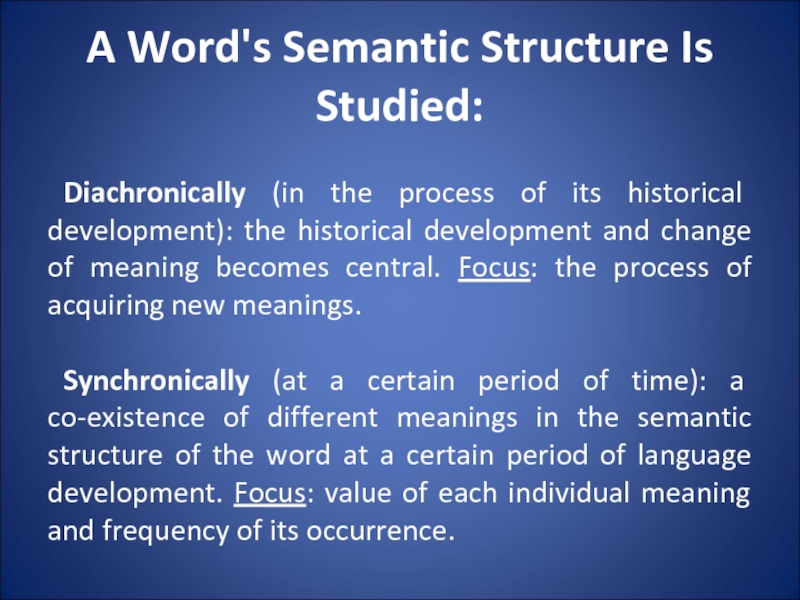
Слайд 50
The meaning first registered in the language
is called primary.
Other meanings are secondary,
or derived, and are placed after the primary one.
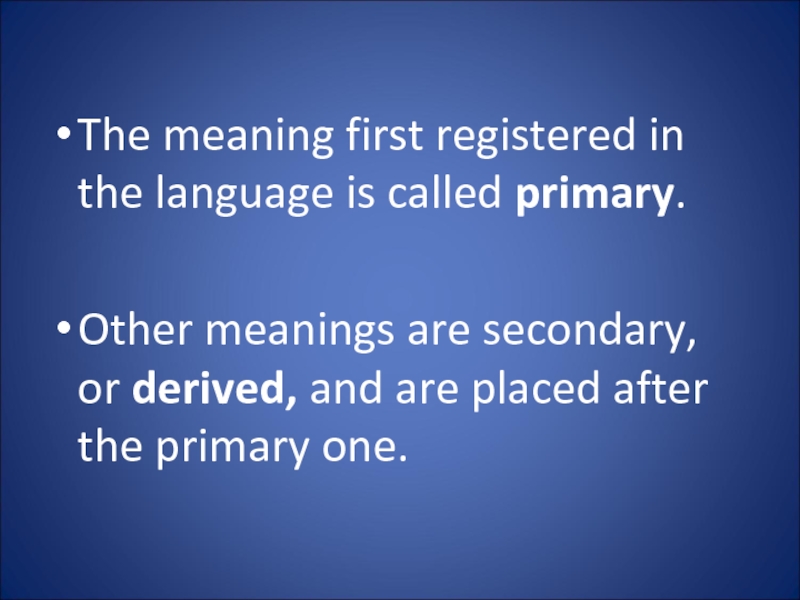
Слайд 51table
a piece of furniture
(primary meaning)
the persons seated at the
table
the food put on the table, meals
a thin flat piece of stone, metal, wood
slabs of stone
words cut into them or written on them
an orderly arrangement of facts
part of a machine-tool on which the work is put to be operated on
a level area, a plateau
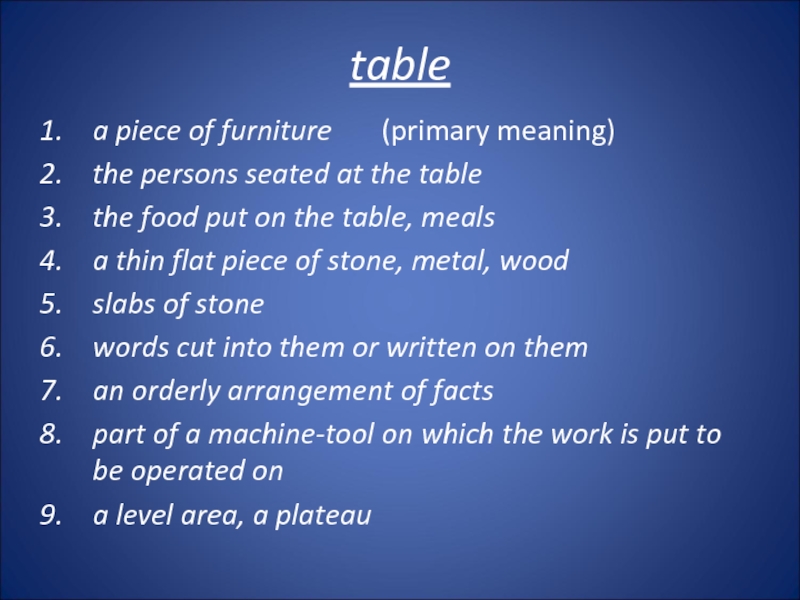
Слайд 52
The meaning that first occurs to our
mind, or is understood without a special
context is called the basic or main meaning.
Other meanings are called peripheral or minor.
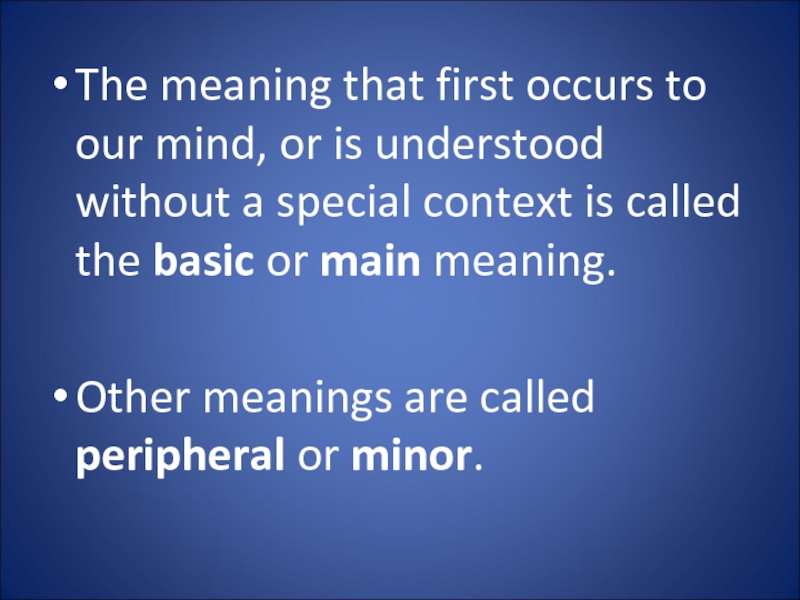
Слайд 53Fire
1. flame (main meaning)
2. an instance of destructive burning
e.g. a forest fire
4. the shooting of guns
e.g. to open fire
3. burning material in a stone, fireplace
e.g. a camp fire
5. strong feeling, passion
e.g. speech lacking fire

Слайд 54Processes of the Semantic Development of a
Word:
radiation (the primary meaning stands in the
center and the secondary meanings proceed out of it like rays. Each secondary meaning can be traced to the primary meaning)
concatenation (secondary meanings of a word develop like a chain. It is difficult to trace some meanings to the primary one)
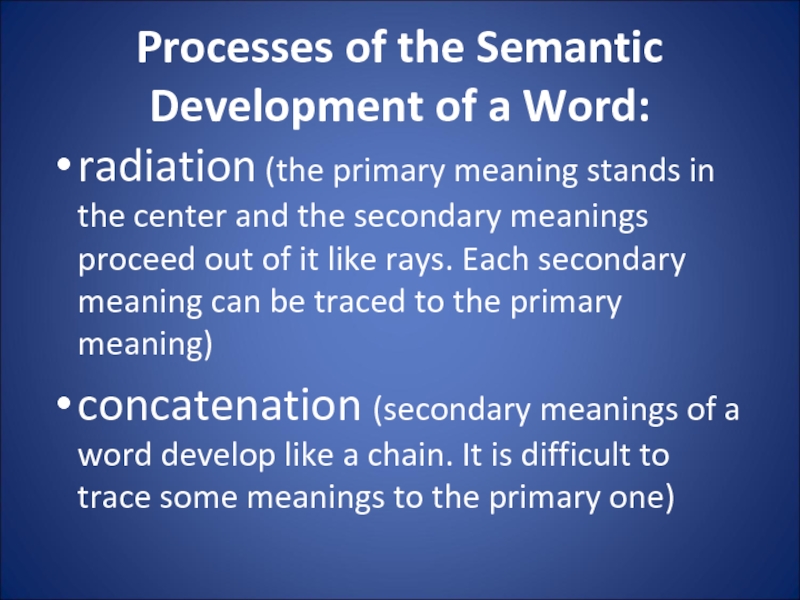
Слайд 55crust
hard outer part of bread
hard
part of anything (a pie, a cake)
harder
layer over soft snow
a sullen gloomy person
Impudence
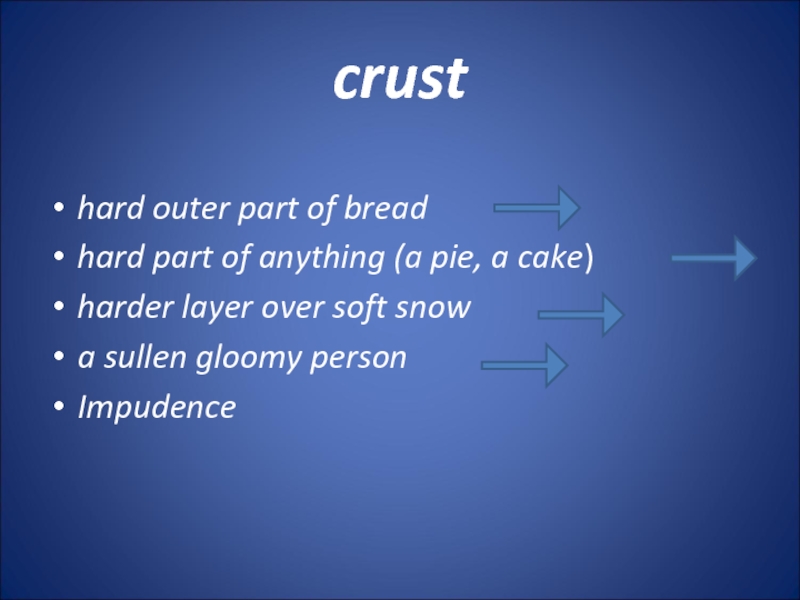
Слайд 56
Polysemy exists not in speech but
in the language.
It’s easy to identify
the main meaning of a separate word. Other meanings are revealed in context.
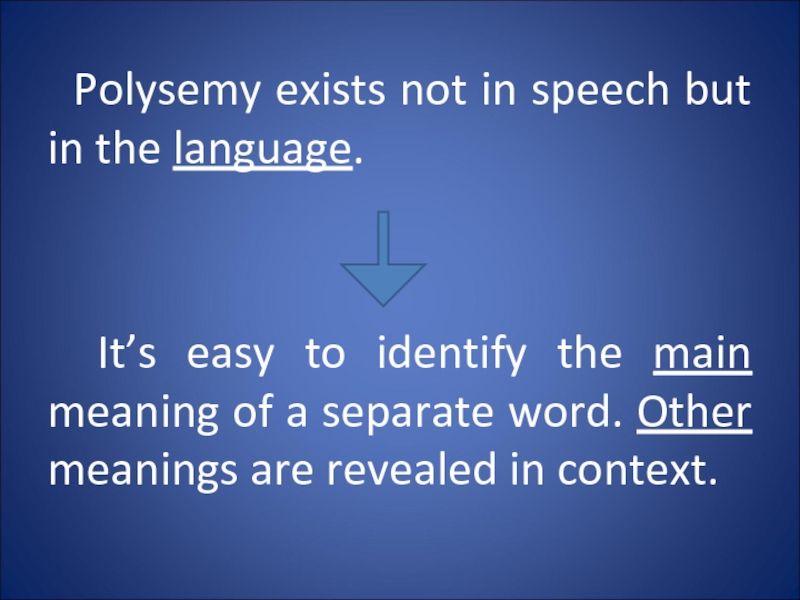
Слайд 57Context:
linguistic
1. lexical – a
number of lexical units around the word
which enter into interaction with it (i.e. words combined with a polysemantic word are important).
2. grammatical – a number of lexical units around the world viewed on the level of parts of speech.
3. thematic – a very broad context, sometimes a text or even a book.
extralinguistic – different cultural, social, historical factors
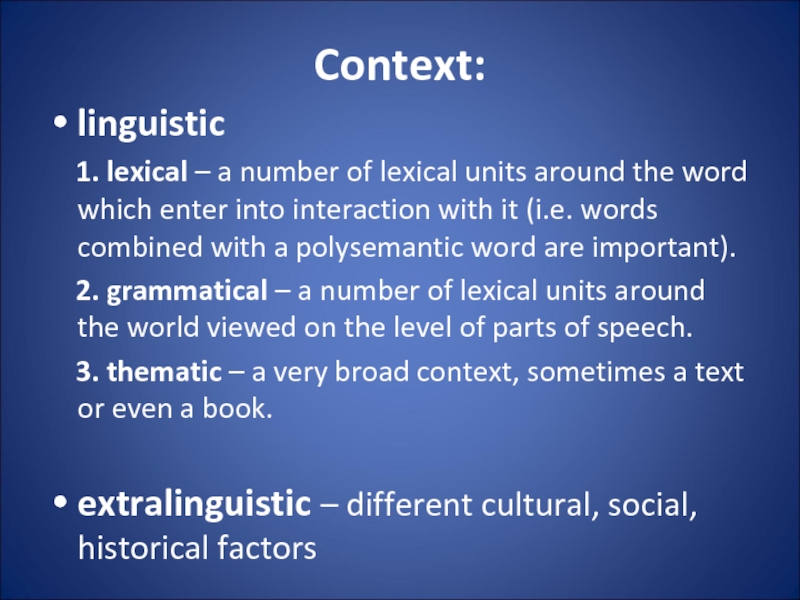
Слайд 58
4. Change of word-meaning: the causes, nature
and results
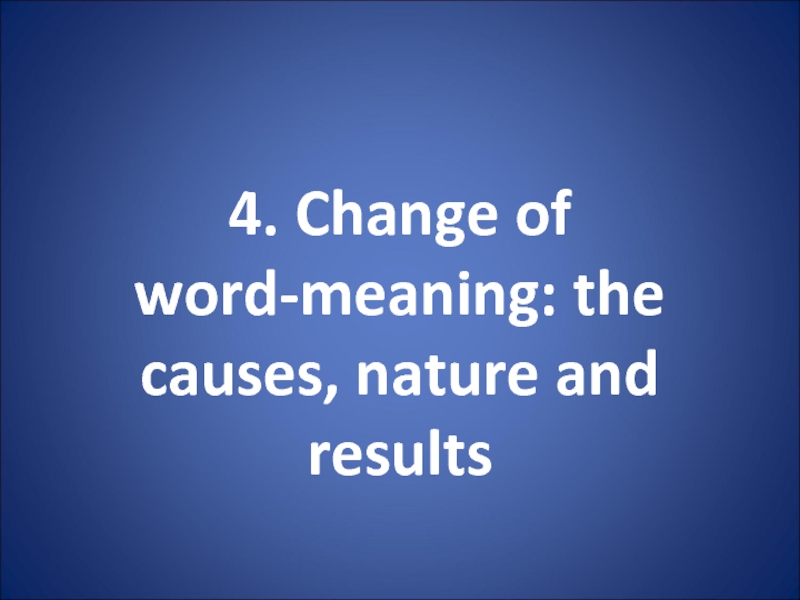
Слайд 59
The meaning of a word can
change in a course of time.
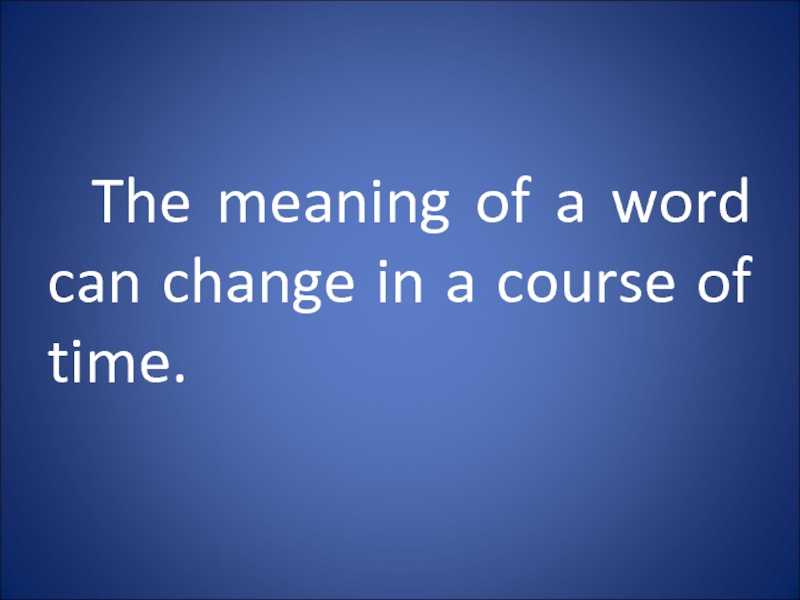
Слайд 60Causes of Change of
Word-meaning:
1. Extralinguistic (various
changes in the life of a speech
community, in economic and social structure, in ideas, scientific concepts)
e.g. “car” meant ‘a four-wheeled wagon’; now – ‘a motor-car’, ‘a railway carriage’ (in the USA)
“paper” is not connected anymore with “papyrus” – the plant from which it formerly was made.
2. Linguistic (factors acting within the language system)
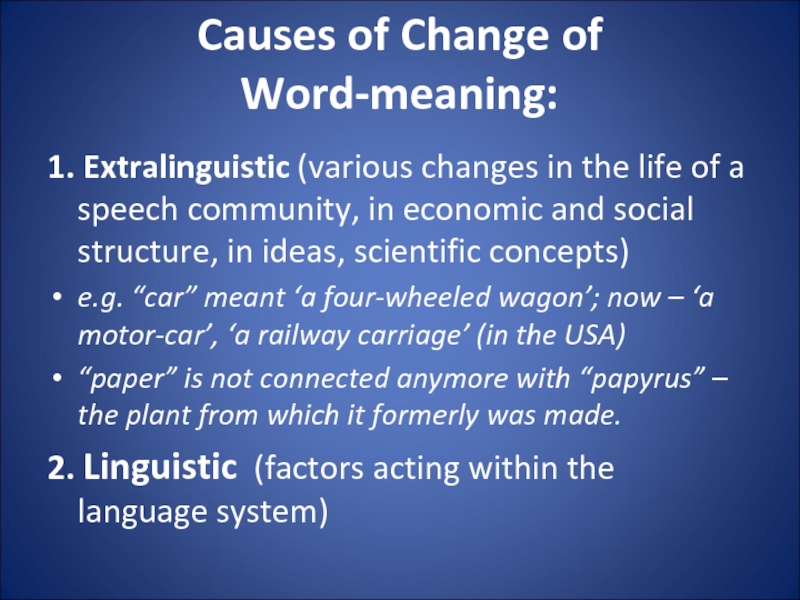
Слайд 61Linguistic Causes:
1. ellipsis – in a phrase
made up of two words one of
these is omitted and its meaning is transferred to its partner.
e.g. “to starve” in O.E. = ‘to die’ + the word “hunger”. In the 16th c. “to starve” = ‘to die of hunger’.
e.g. daily = daily newspaper
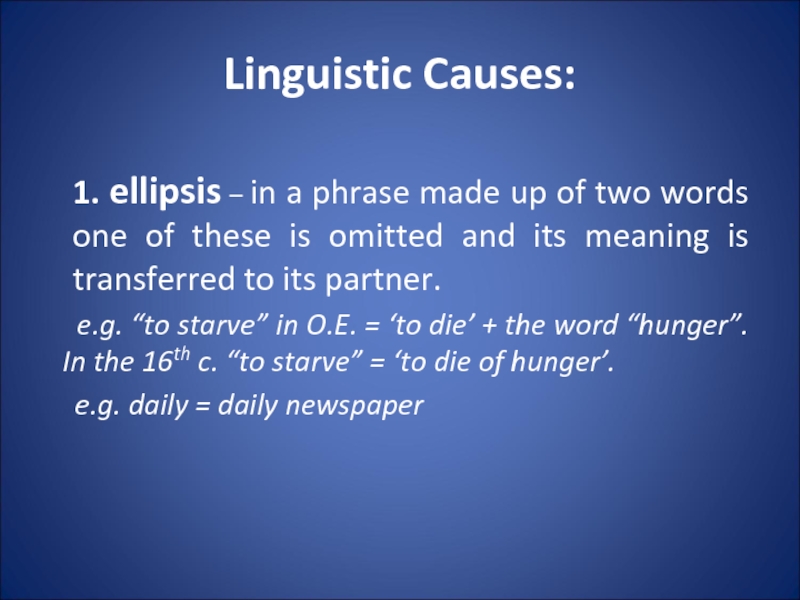
Слайд 62Linguistic Causes:
2. differentiation (discrimination) of synonyms
– when a new word is borrowed
it may become a perfect synonym for the existing one. They have to be differentiated; otherwise one of them will die.
e.g. “land” in O.E. = both ‘solid part of earth’s surface’ and ‘the territory of the nation’. In the middle E. period the word “country” was borrowed as its synonym; ‘the territory of a nation’ came to be denoted mainly by “country”.
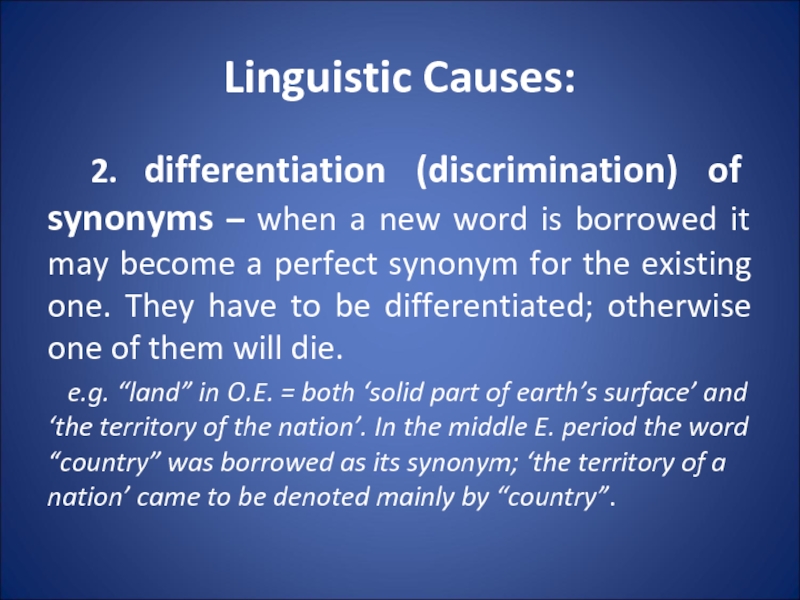
Слайд 63Linguistic Causes:
3. linguistic analogy – if one
of the members of the synonymic set
acquires a new meaning, other members of this set change their meaning too.
e.g. “to catch” acquired the meaning ‘to understand’; its synonyms “to grasp” and “to get” acquired this meaning too.

Слайд 64
The nature of semantic changes
is based on the secondary application of
the word form to name a different yet related concept.
Conditions to any semantic change: some connection between the old meaning and the new.
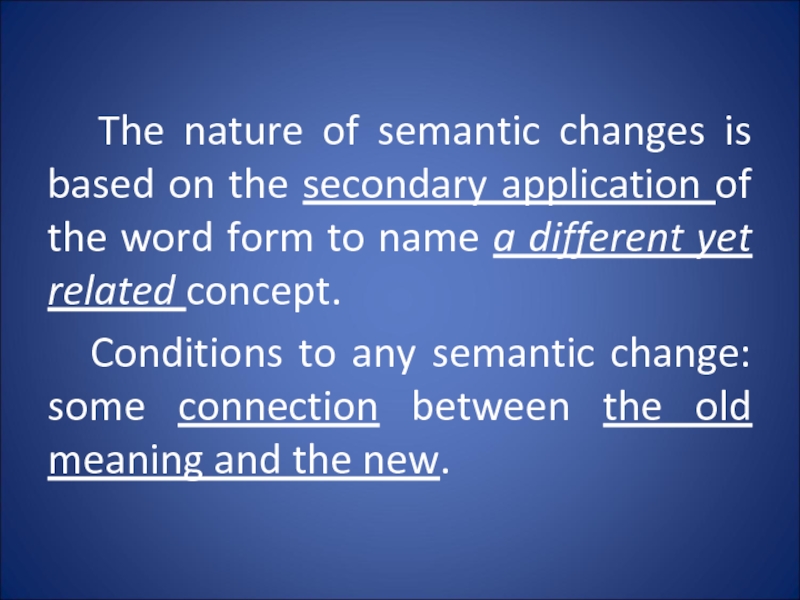
Слайд 65Association between Old Meaning and New:
similarity of
meanings or metaphor – a semantic process
of associating two referents one of which in some way resembles the other
contiguity (closeness) of meanings or metonymy – a semantic process of associating two referents one of which makes part of the other or is closely connected with it
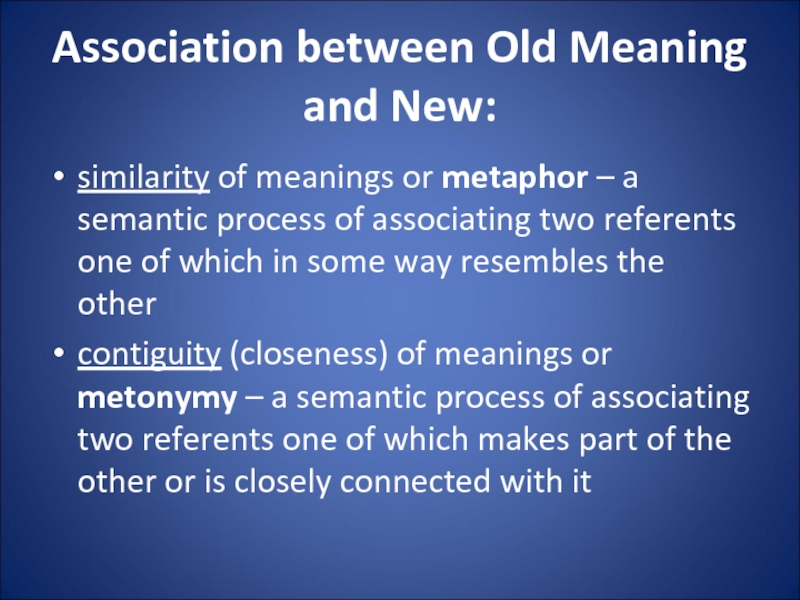
Слайд 66Types of Metaphor:
a) similarity of shape, e.g.
head (of a cabbage), bottleneck, teeth (of
a saw, a comb);
b) similarity of position, e.g. foot (of a page, of a mountain), head (of a procession);
c) similarity of function, behavior, e.g. a bookworm (a person who is fond of books);
d) similarity of color, e.g. orange, hazel, chestnut.
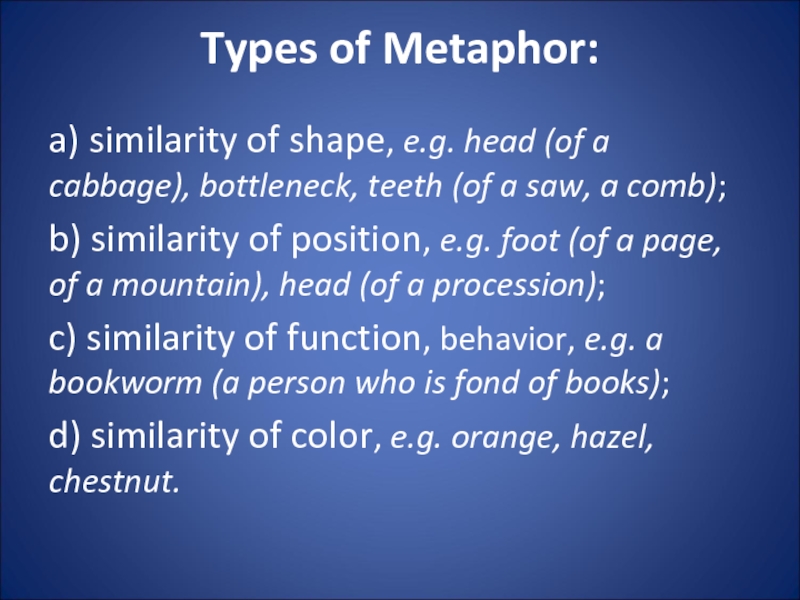
Слайд 67Types of Metonymy:
‘material — object of it’
(She is wearing a fox);
‘container — containее’
(I ate three plates);
‘place — people’ (The city is asleep);
‘object — a unit of measure’ (This horse came one neck ahead);
‘producer — product’ (We bought a Picasso);
‘whole — part’ (We have 10 heads here);
‘count — mass’ (We ate rabbit)
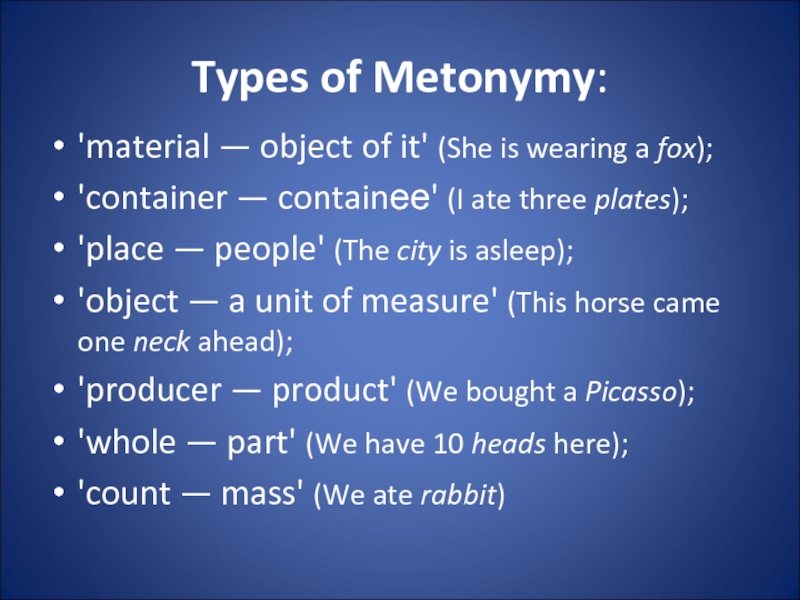
Слайд 68Results of Semantic Change:
changes in the denotational
component
changes in the connotational meaning
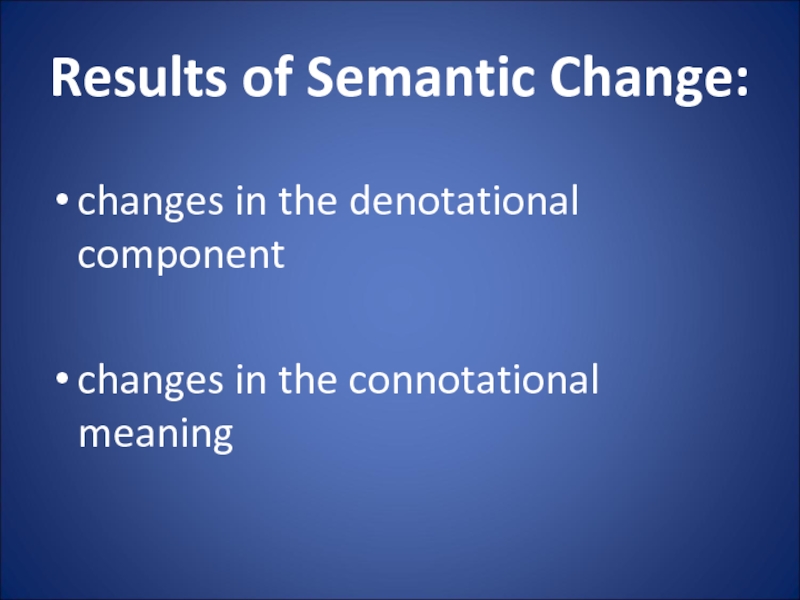
Слайд 69Changes in the Denotational Component:
restriction – a
word denotes a restricted number of referents.
e.g. “fowl” in O.E. = ‘any bird’, but now ‘a domestic hen or chicken’
extension – the application of the word to a wider variety of referents
e.g. ‘‘a cook’’ was not applied to women until the 16th century.
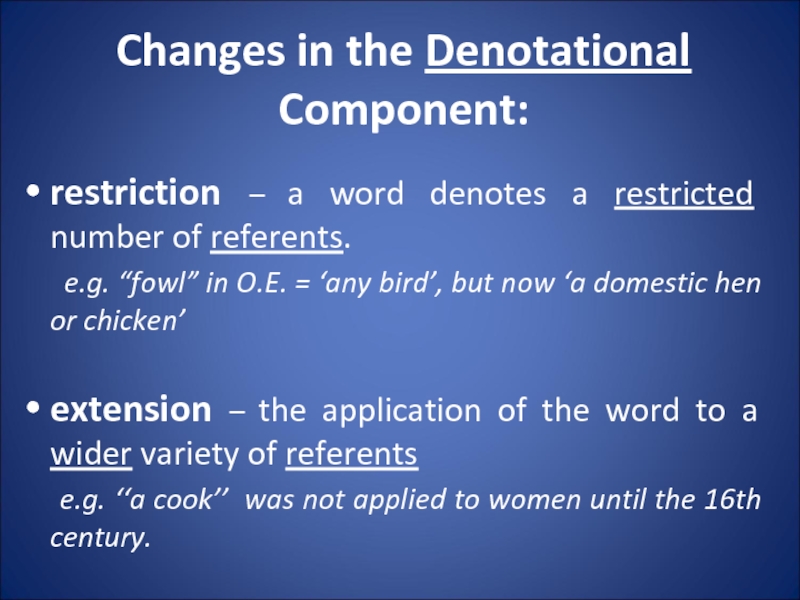
Слайд 70
generalization – the word with the extended
meaning passes from the specialized vocabulary into
common use and the meaning becomes more general.
e.g. “camp” = ‘the place where troops are lodged in tents’; now – ‘temporary quarters’.
specialization – the word with the new meaning comes to be used in the specialized vocabulary of some limited group.
e.g. “to glide” = ‘to move gently and smoothly’ and now has acquired a special meaning – ‘to fly with no engine’.
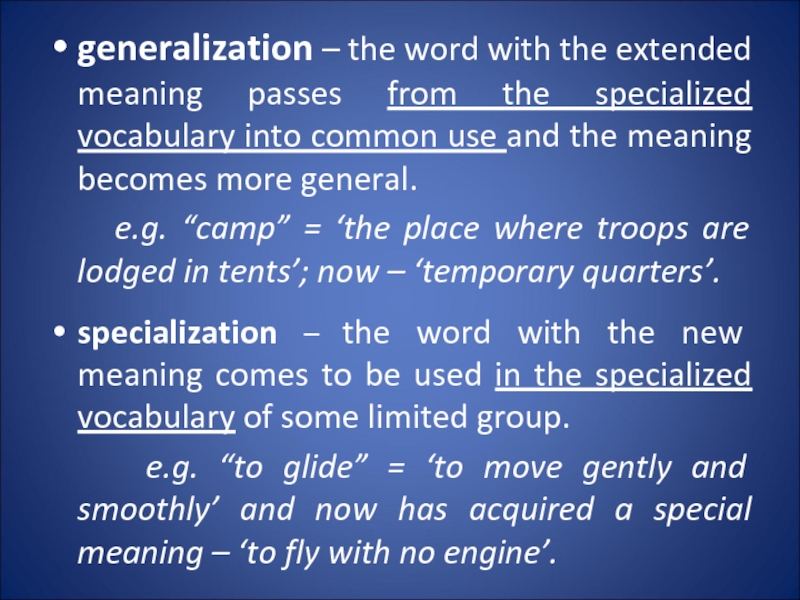
Слайд 71Changes in the Connotational Meaning:
pejorative development (degradation)
– the acquisition by the word of
some derogatory emotive charge.
e.g. “accident” ‘a happening causing loss or injury’ came from more neutral ‘something that happened’;
ameliorative development (elevation) – the improvement of the connotational component of meaning.
e.g. “a minister” denoted a servant, now – ‘a civil servant of higher rank, a person administering a department of state’
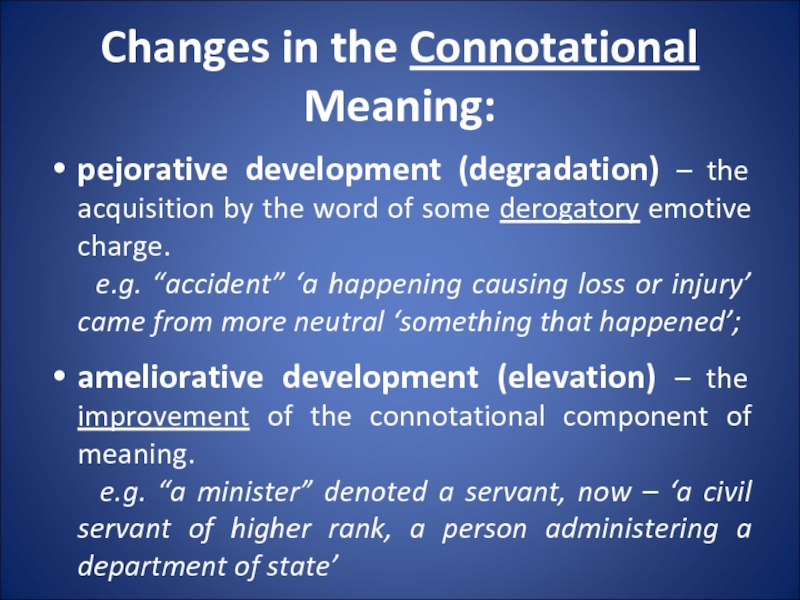
Слайд 72List of Literature:
Антрушина, Г. Б. Лексикология английского
языка: учебник для студ. пед. ин-тов по
спец. № 2103 «Иностр. яз.» / Г. Б. Антрушина, О. В. Афанасьева, Н. Н. Морозова; под ред. Г. Б. Антрушиной. – М.: Высш. школа, 1985. – С. 129–142, 147–160.
Воробей, А. Н. Глоссарий лингвистических терминов / А. Н. Воробей, Е. Г. Карапетова. – Барановичи: УО «БарГУ», 2004. – 108 с.
Дубенец, Э. М. Современный английский язык. Лексикология: пособие для студ. гуманит. вузов / Э. М. Дубенец. – М. / СПб.: ГЛОССА / КАРО, 2004. – С. 74–82, 123–127.
Лексикология английского языка: учебник для ин-тов и фак-тов иностр. яз. / Р. З. Гинзбург [и др.]; под общ. ред. Р. З. Гинзбург. – 2-е изд., испр. и доп. – М.: Высш. школа, 1979. – С. 13–23, 28–39, 47–51.
Лещева, Л. М. Слова в английском языке. Курс лексикологии современного английского языка: учебник для студ. фак-в и отдел. английского языка (на англ. яз.) / Л. М. Лещева. – Минск: Академия управления при Президенте Республики Беларусь, 2001. – С. 36–56.
